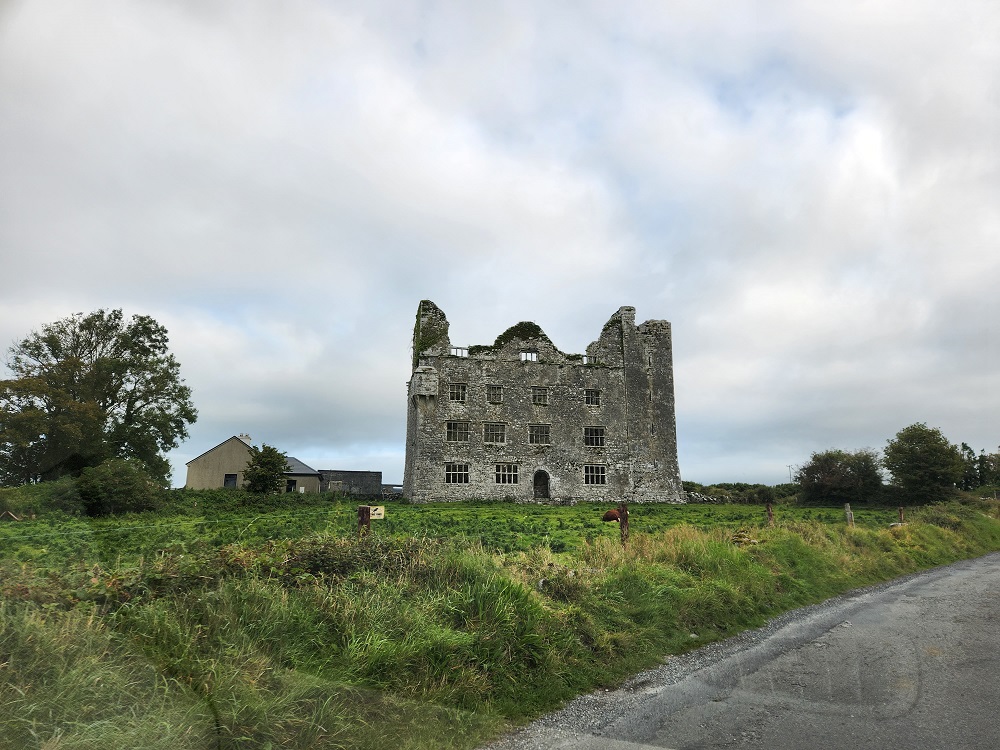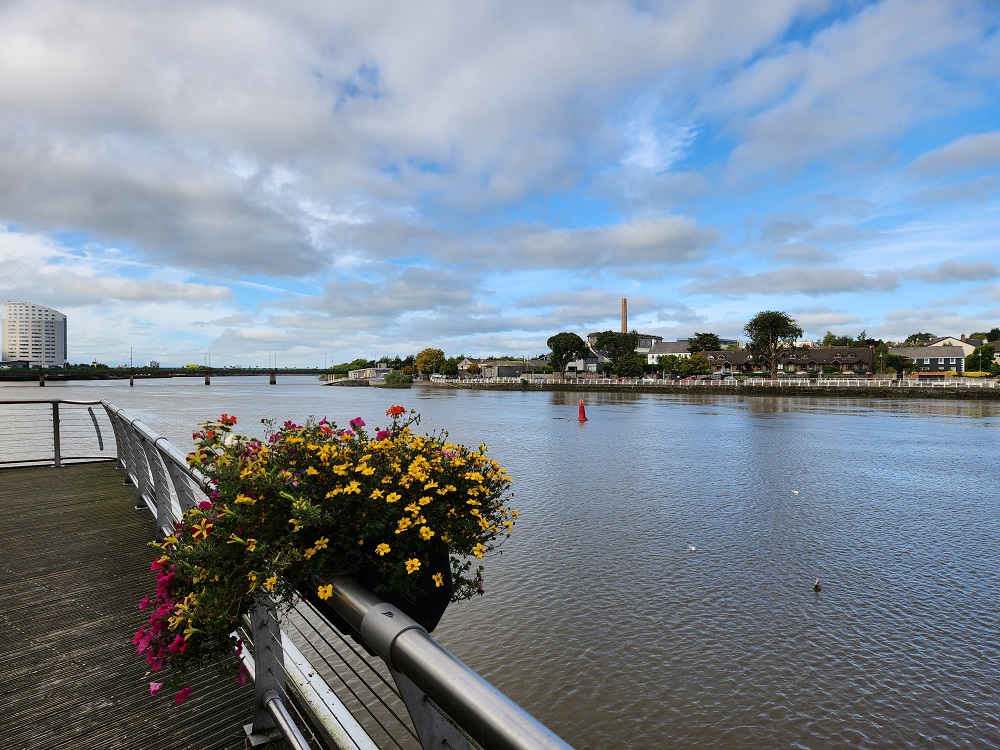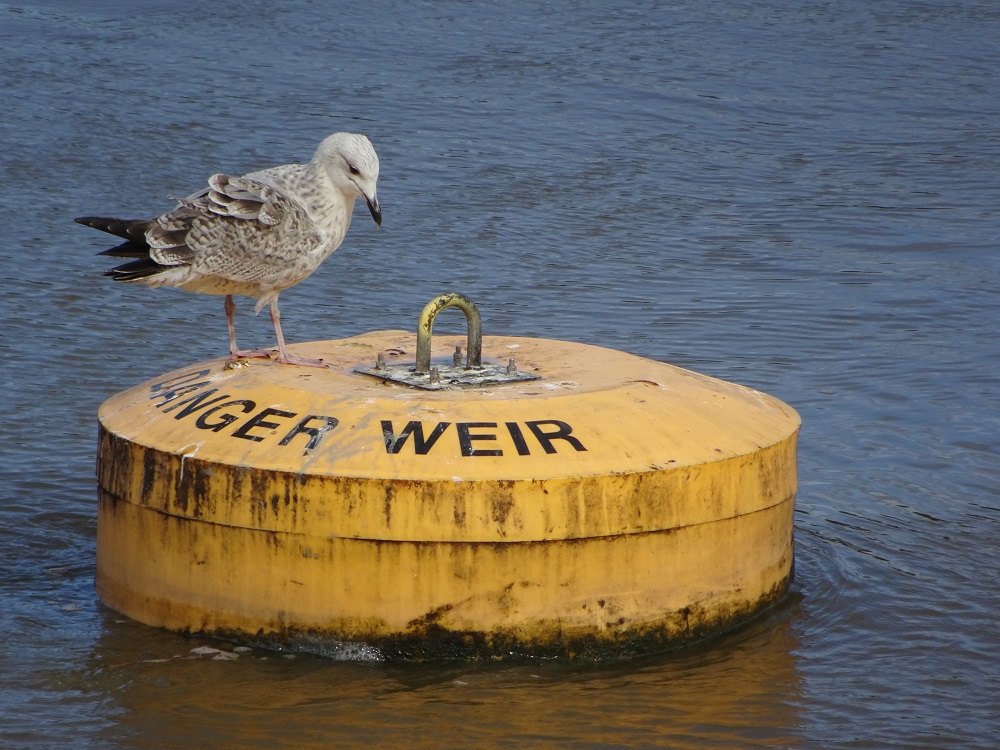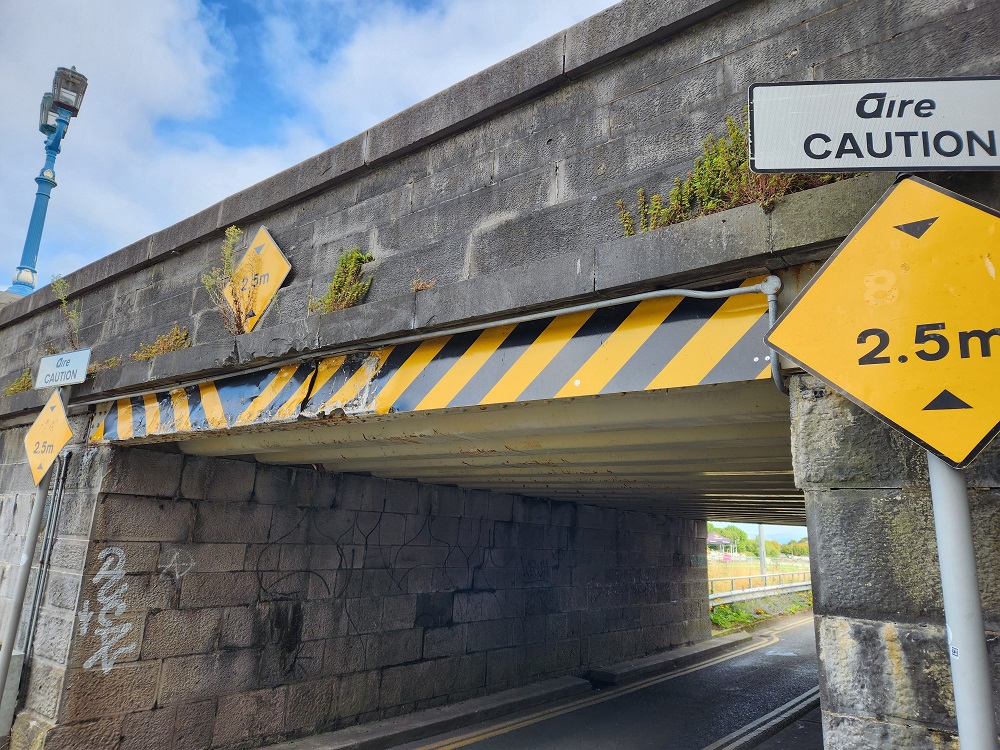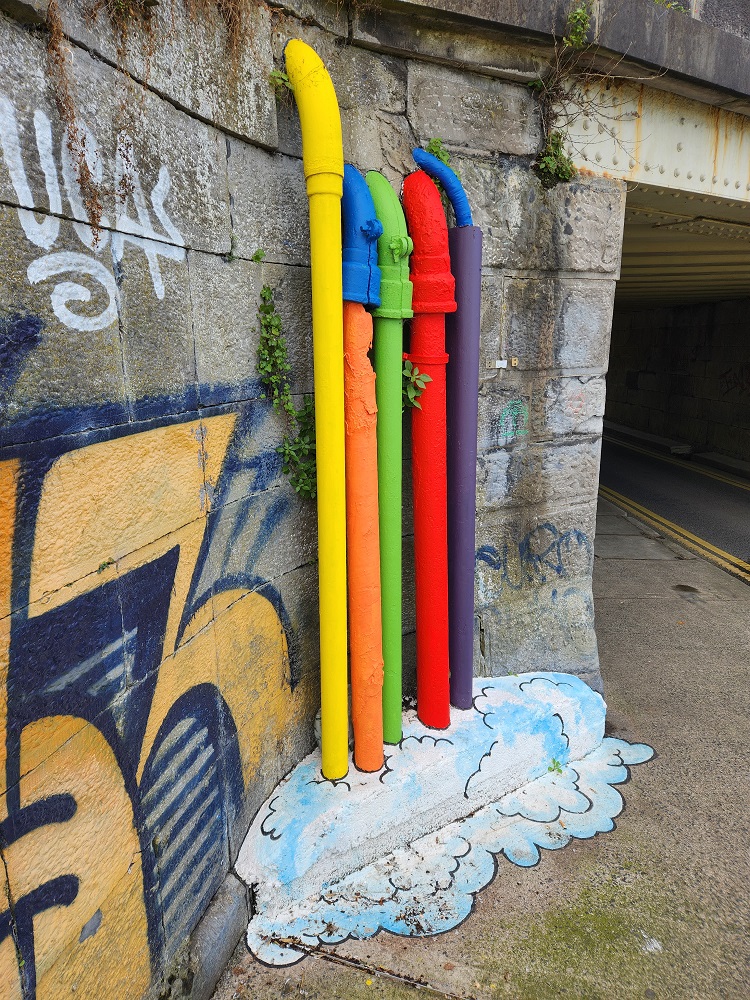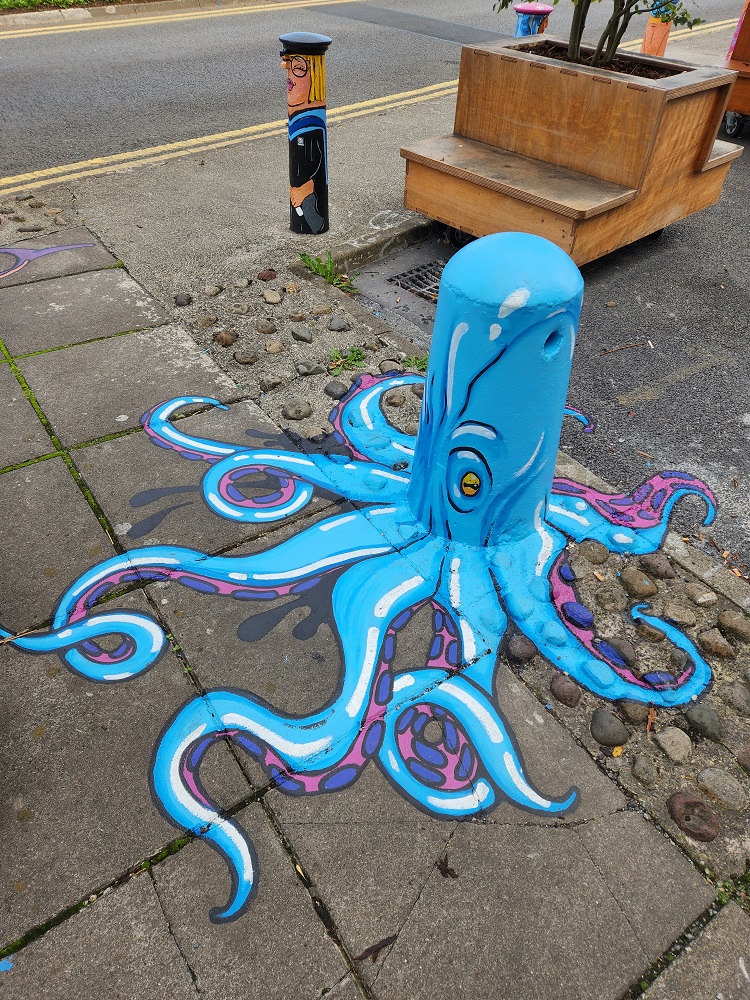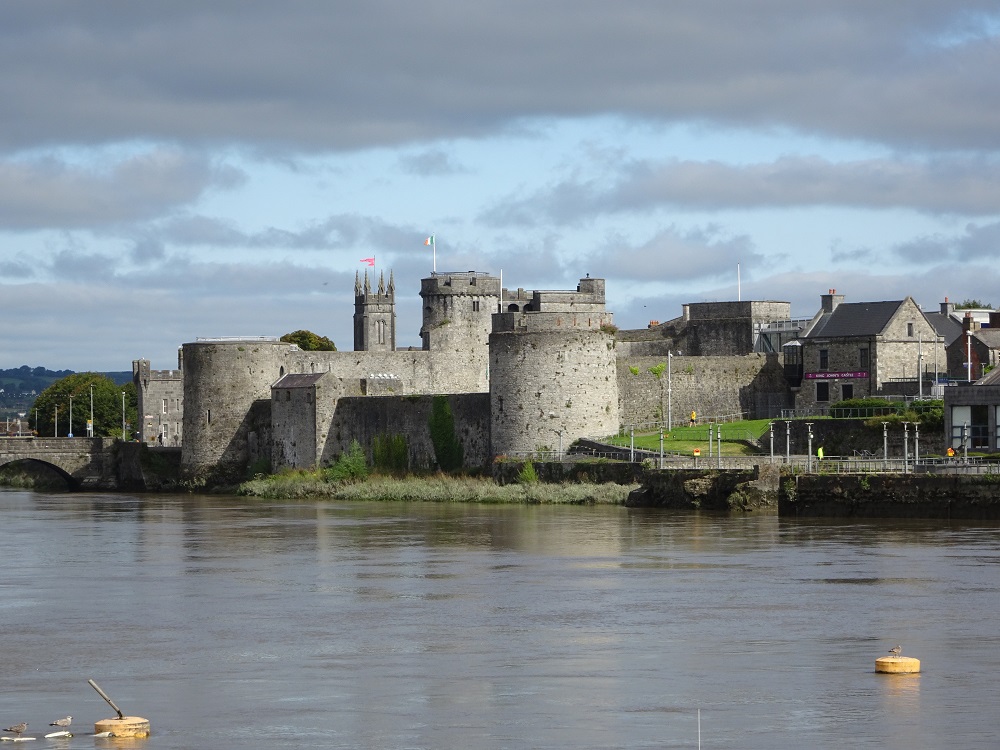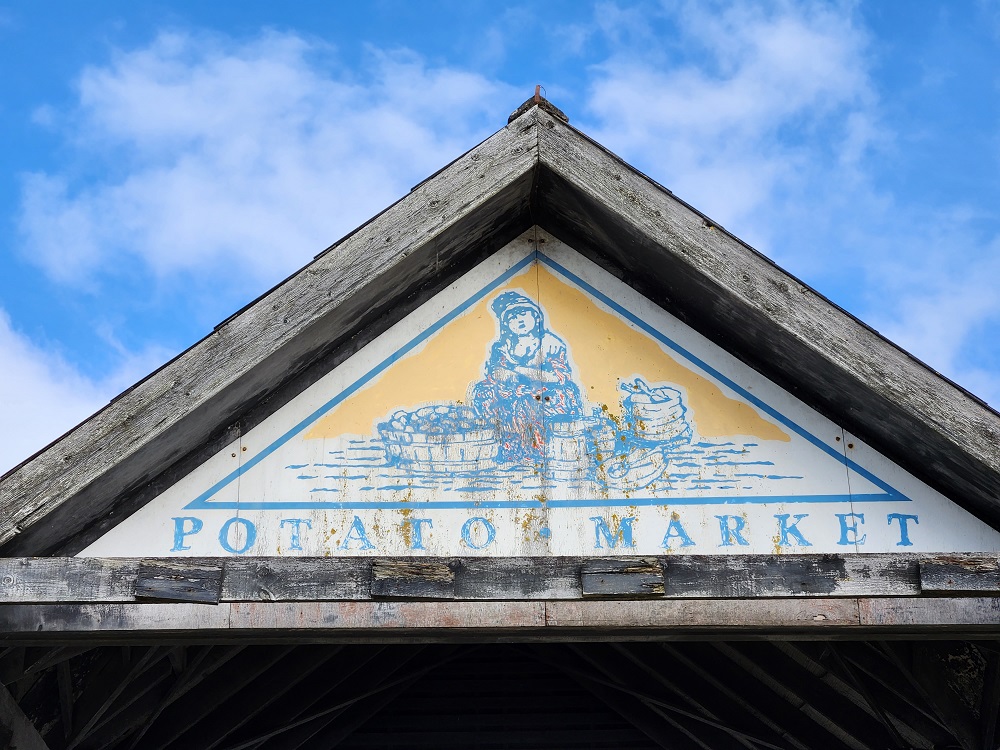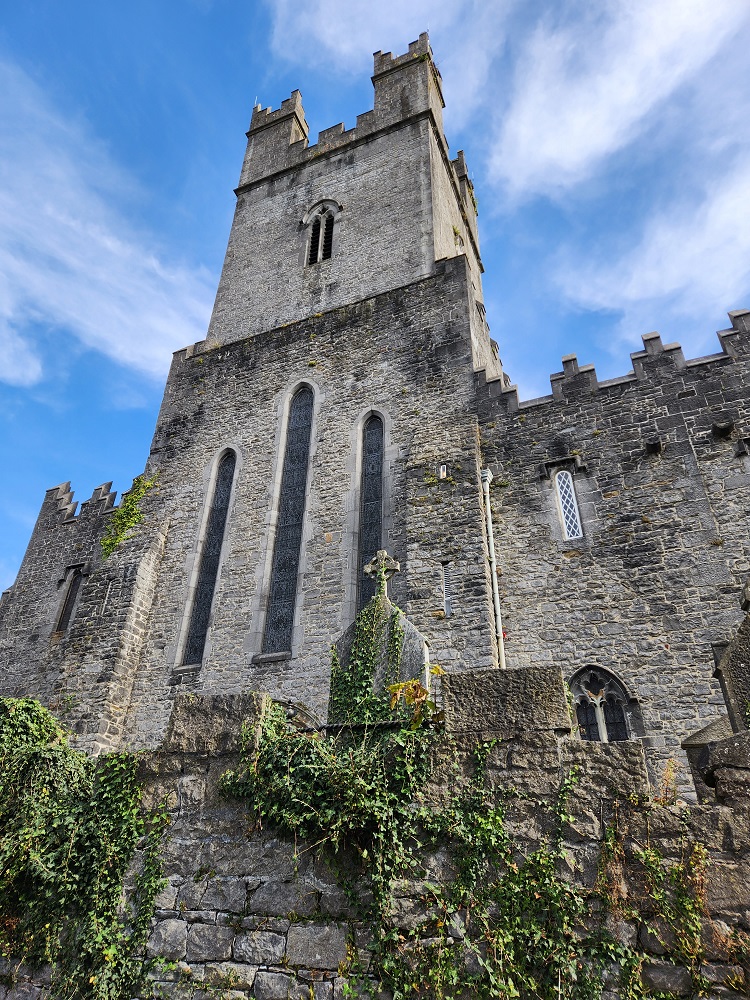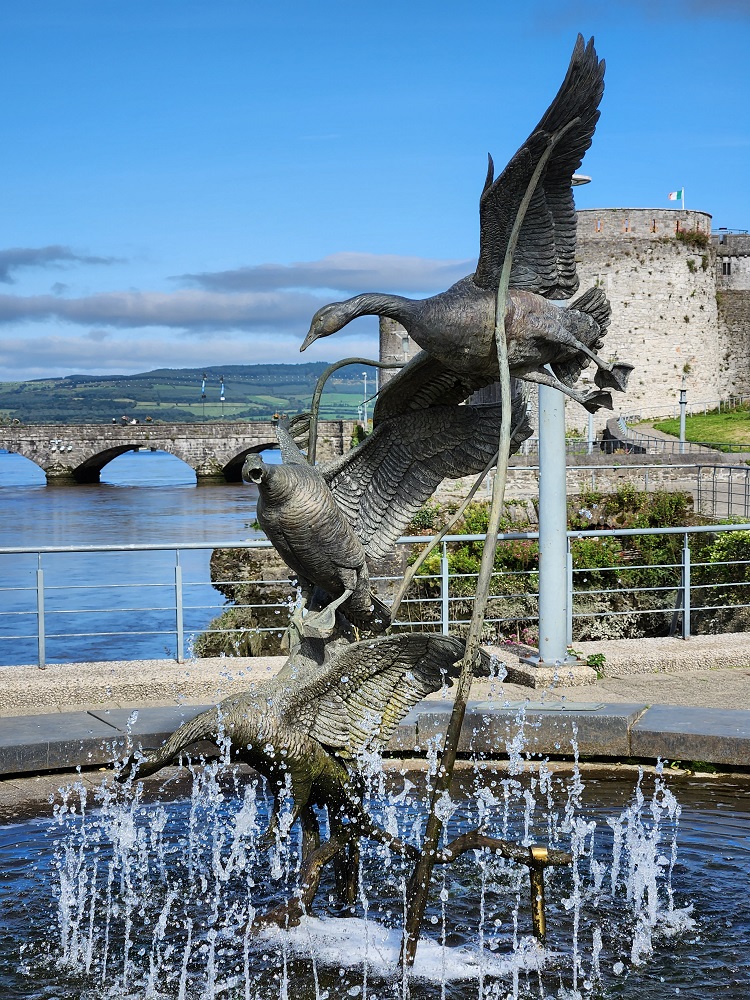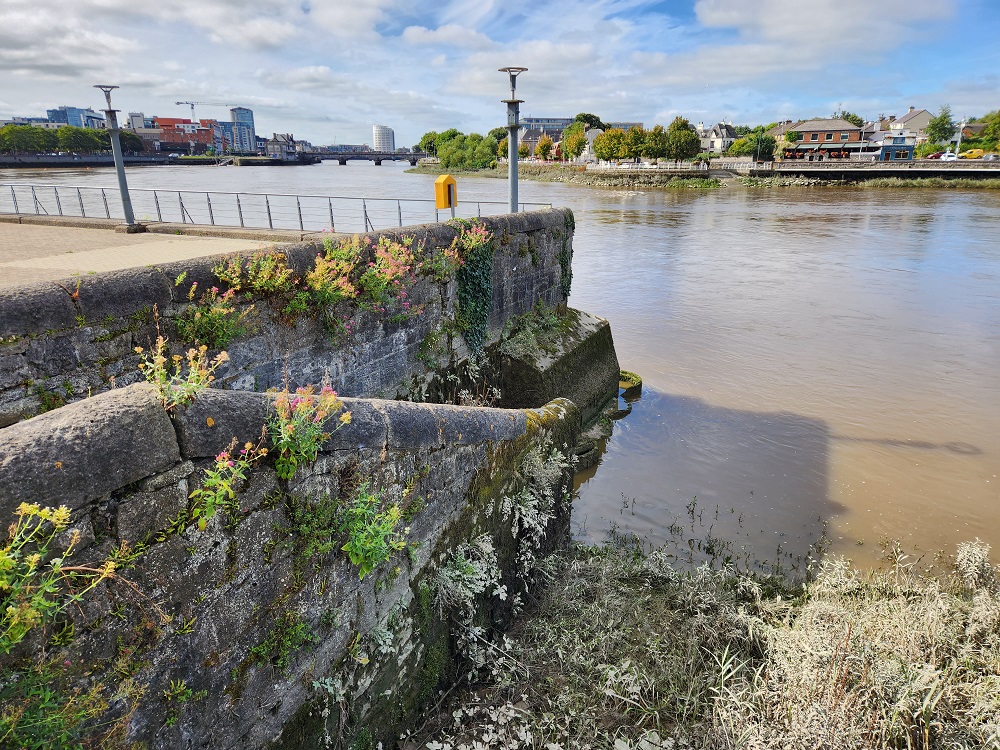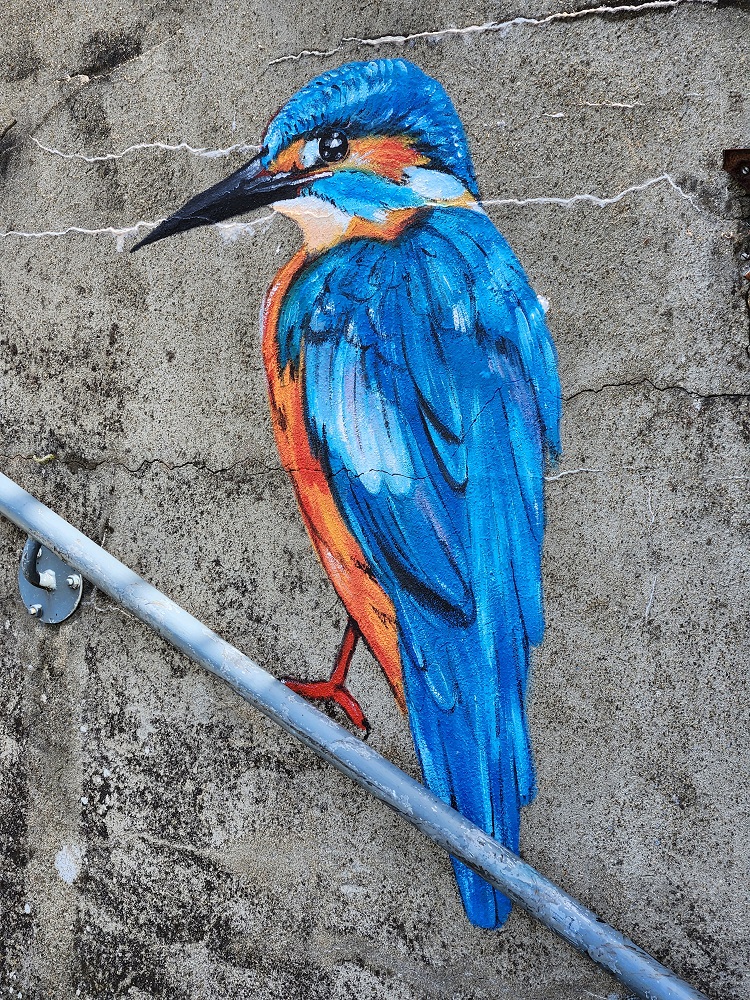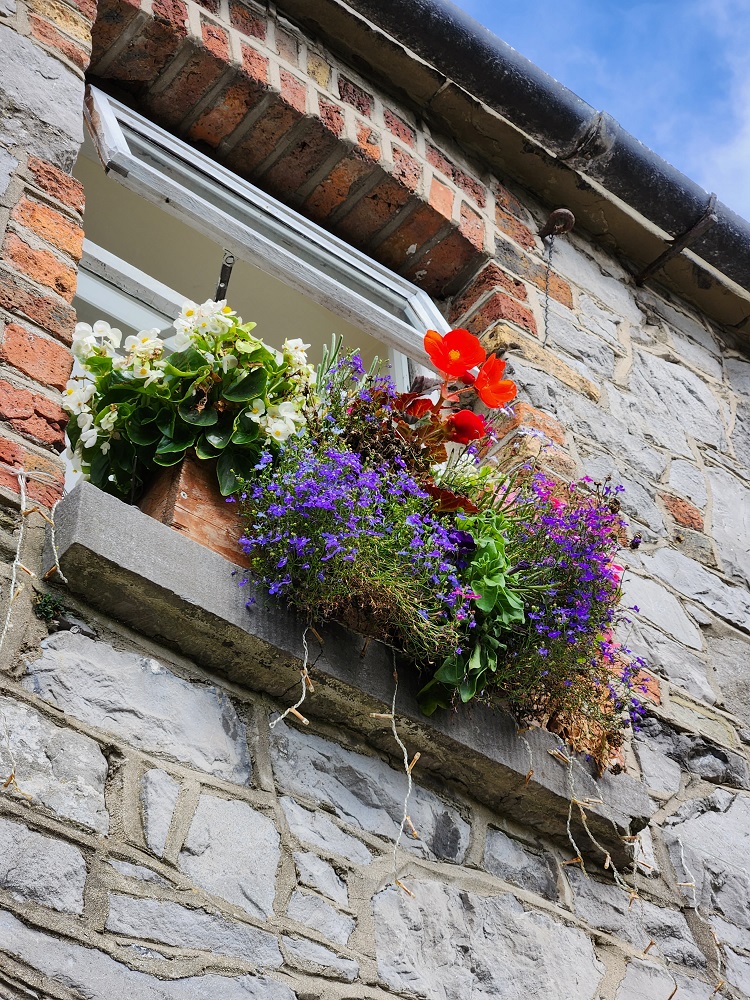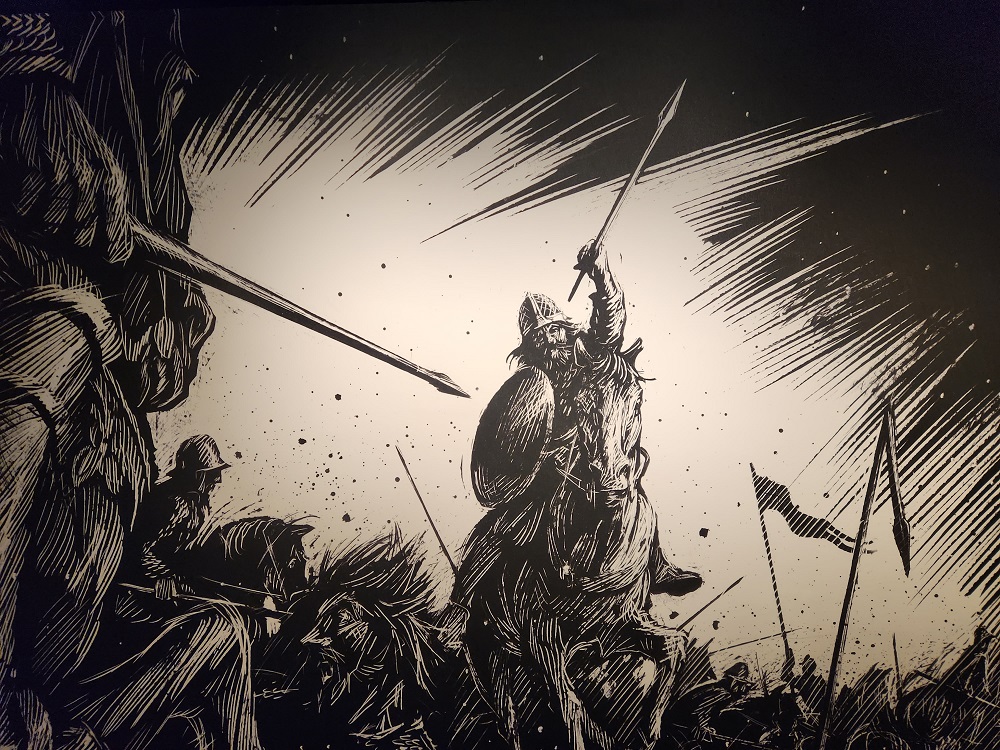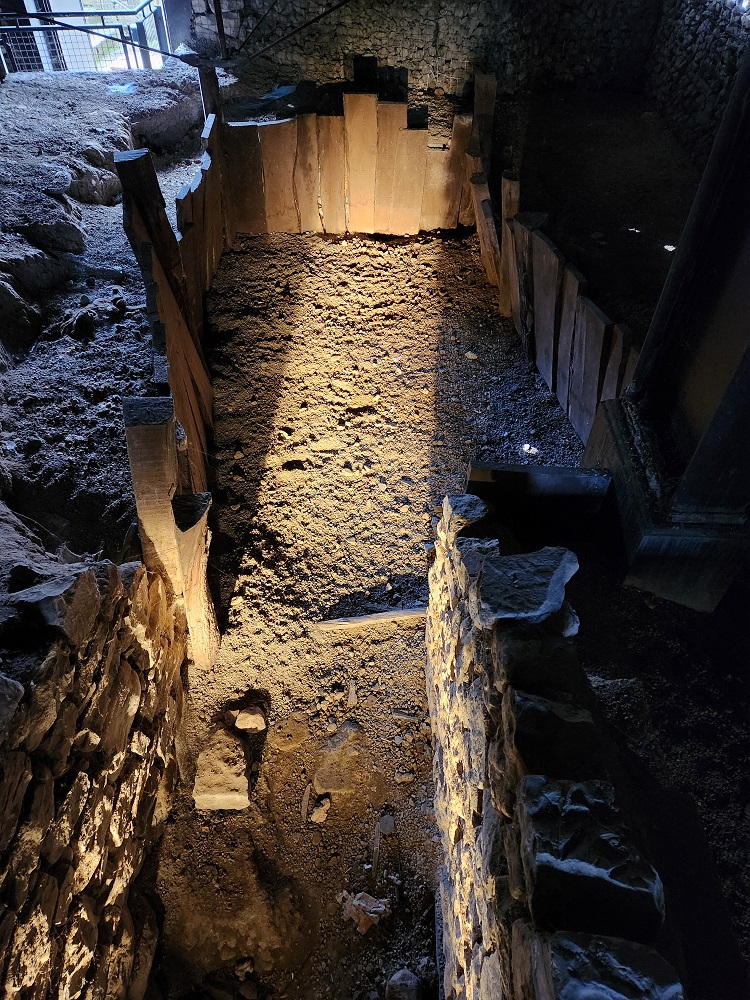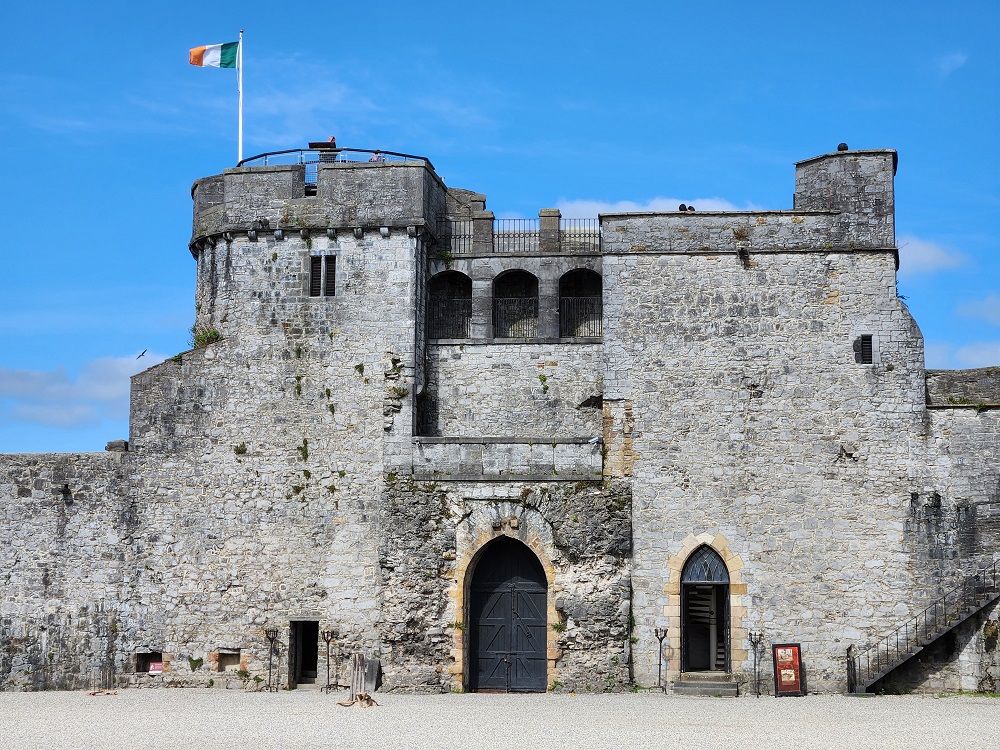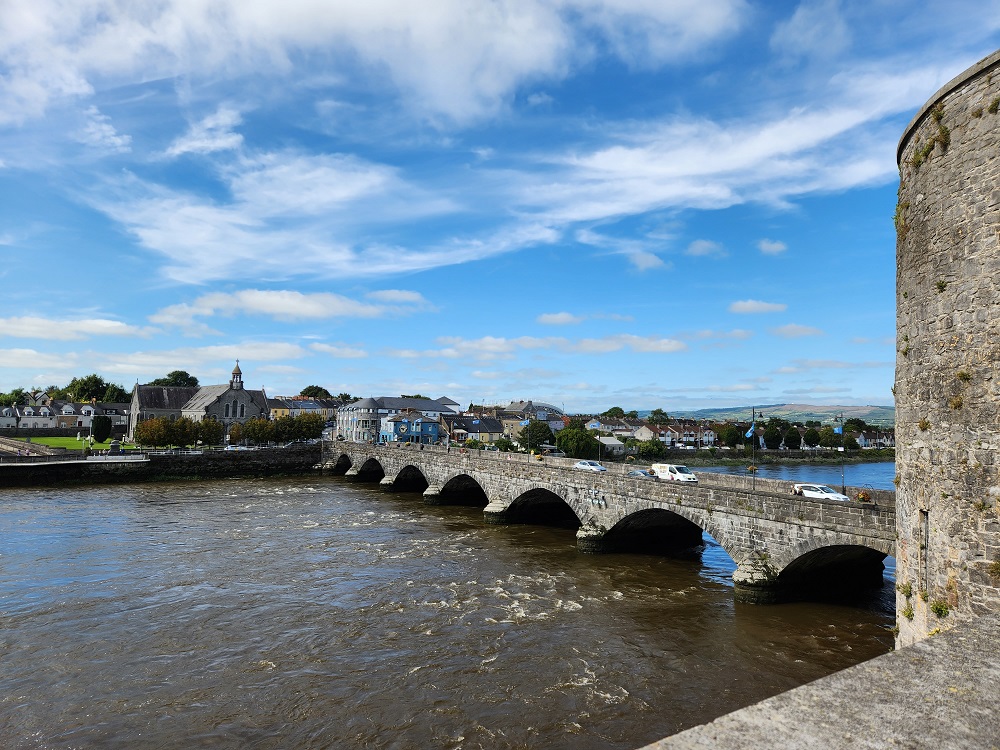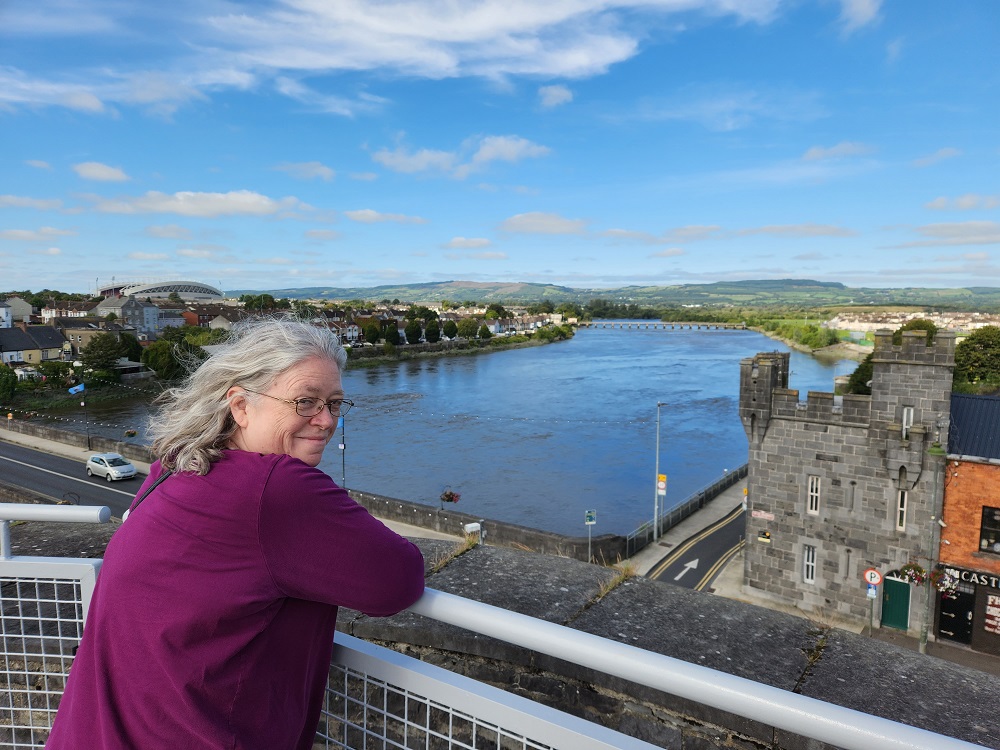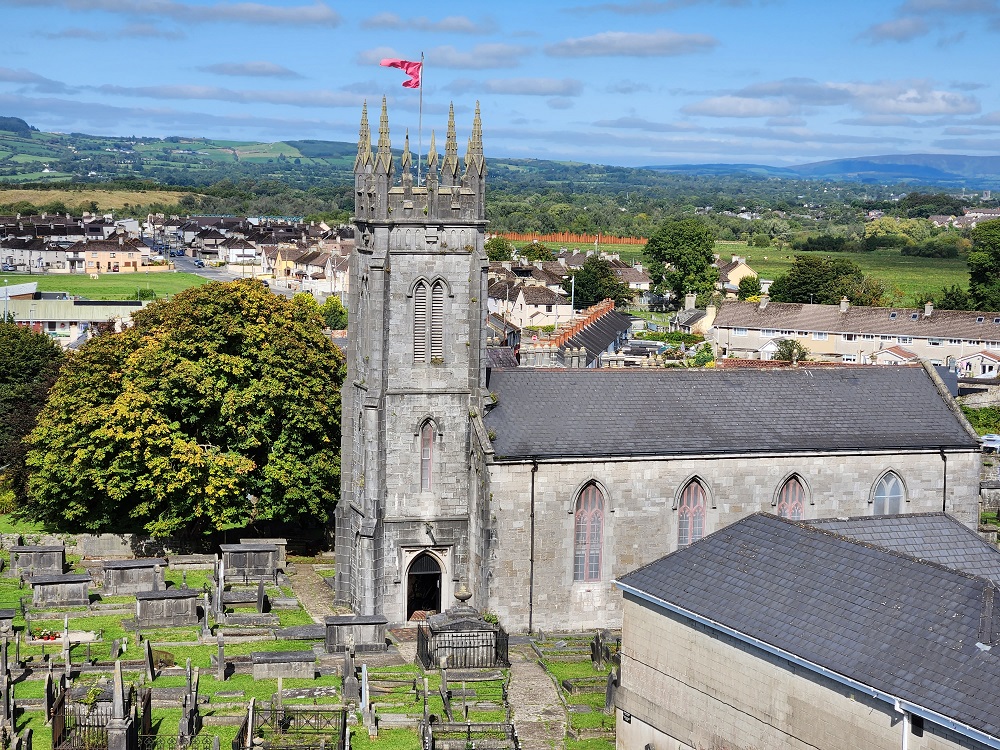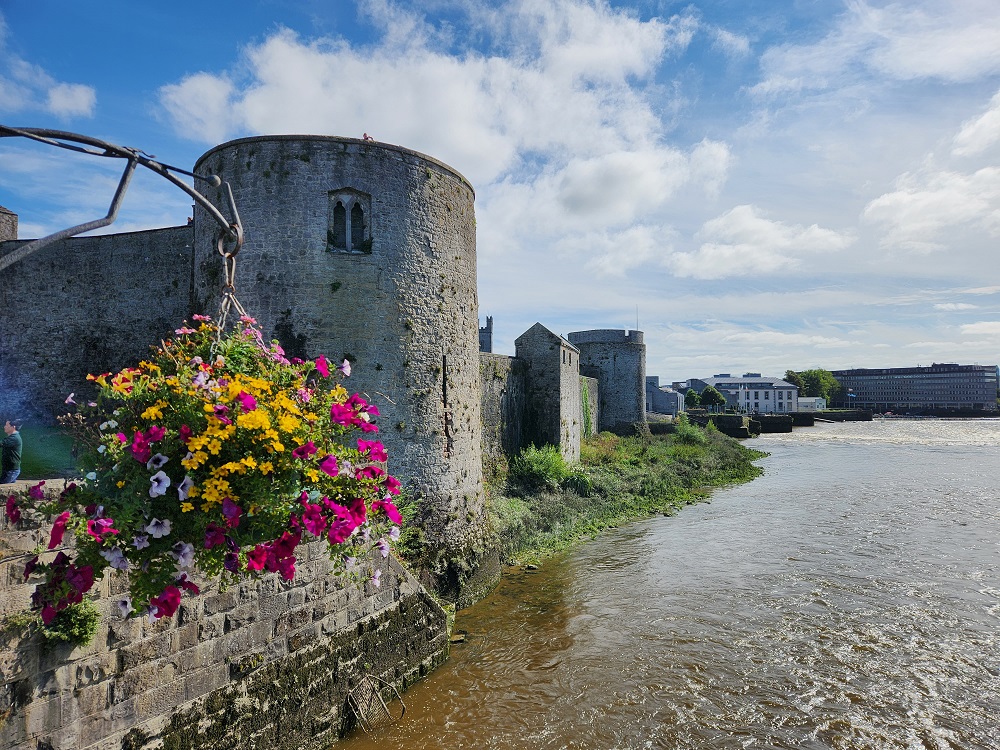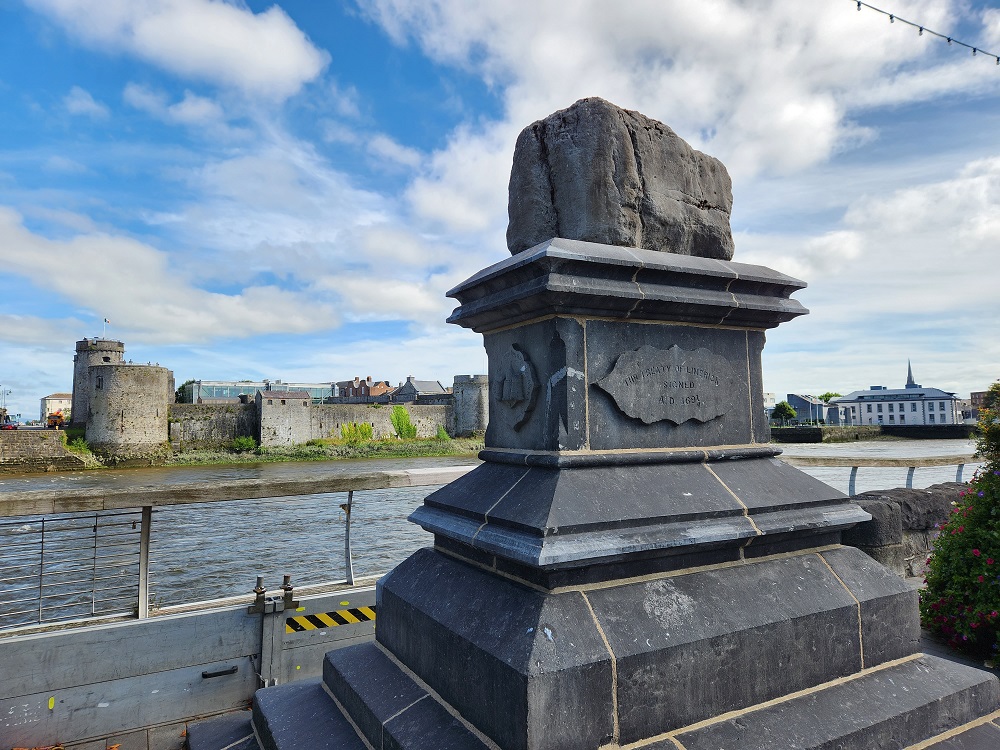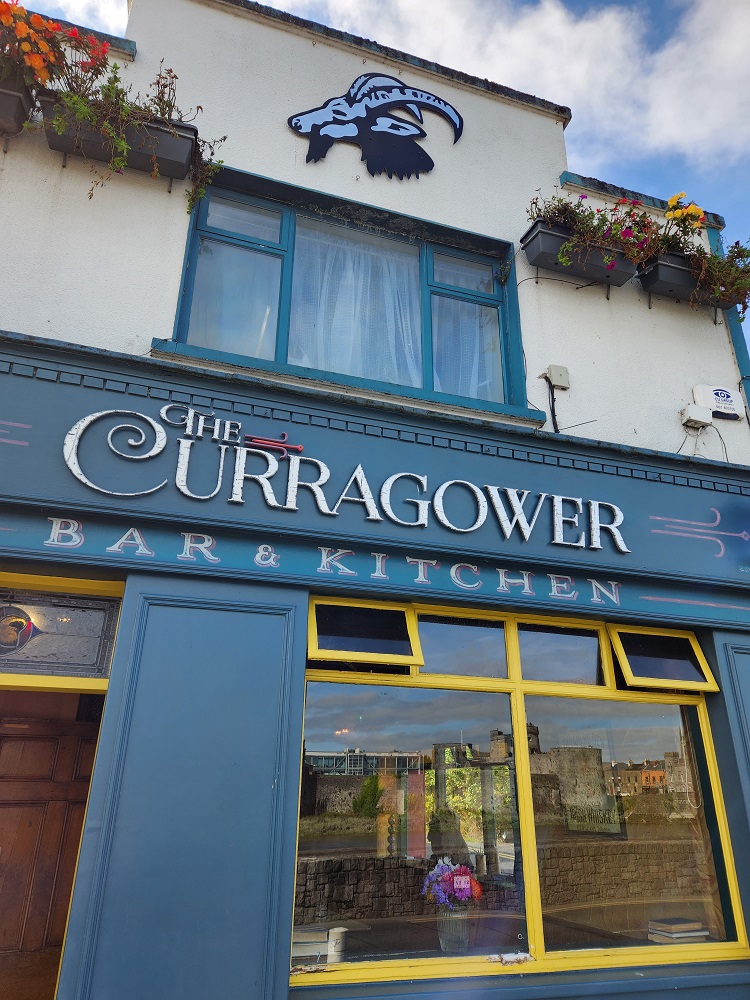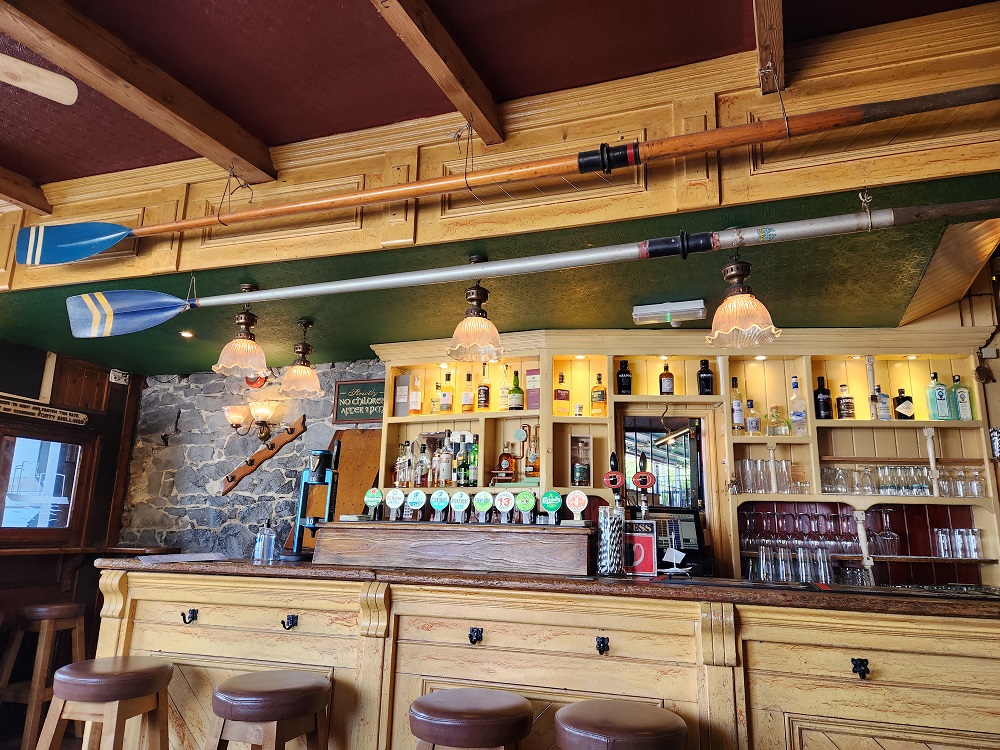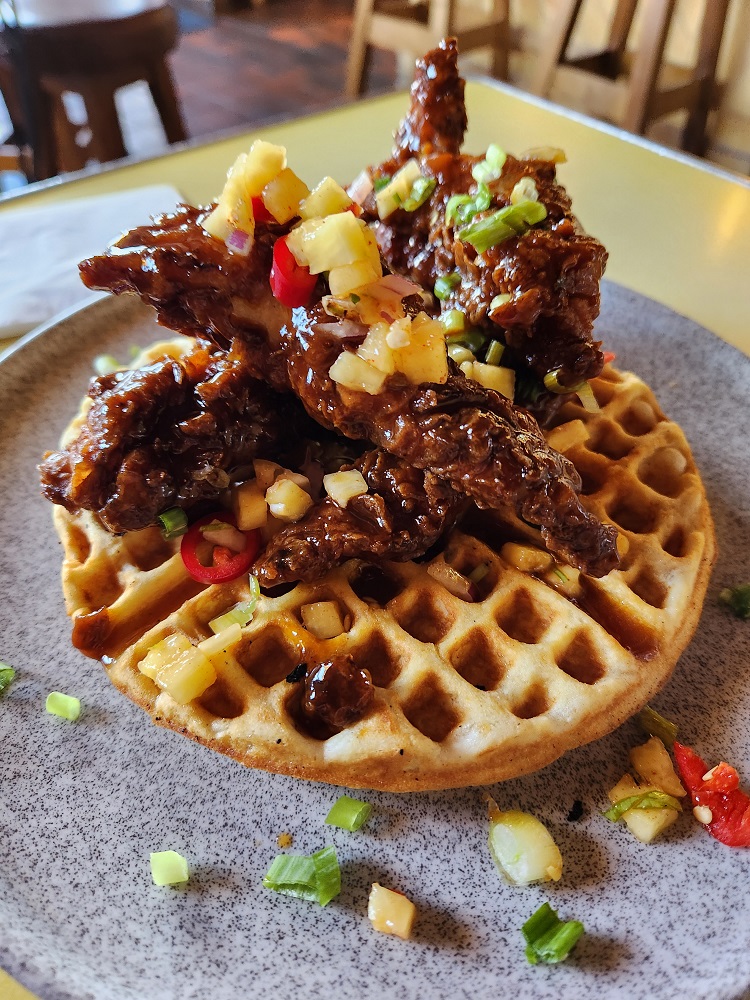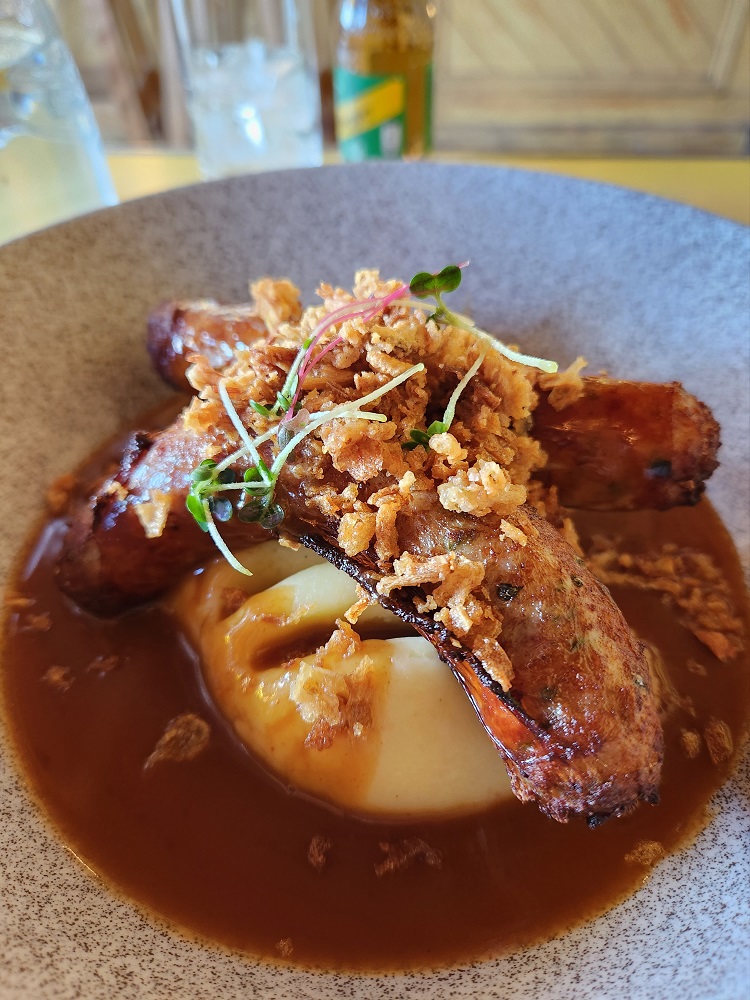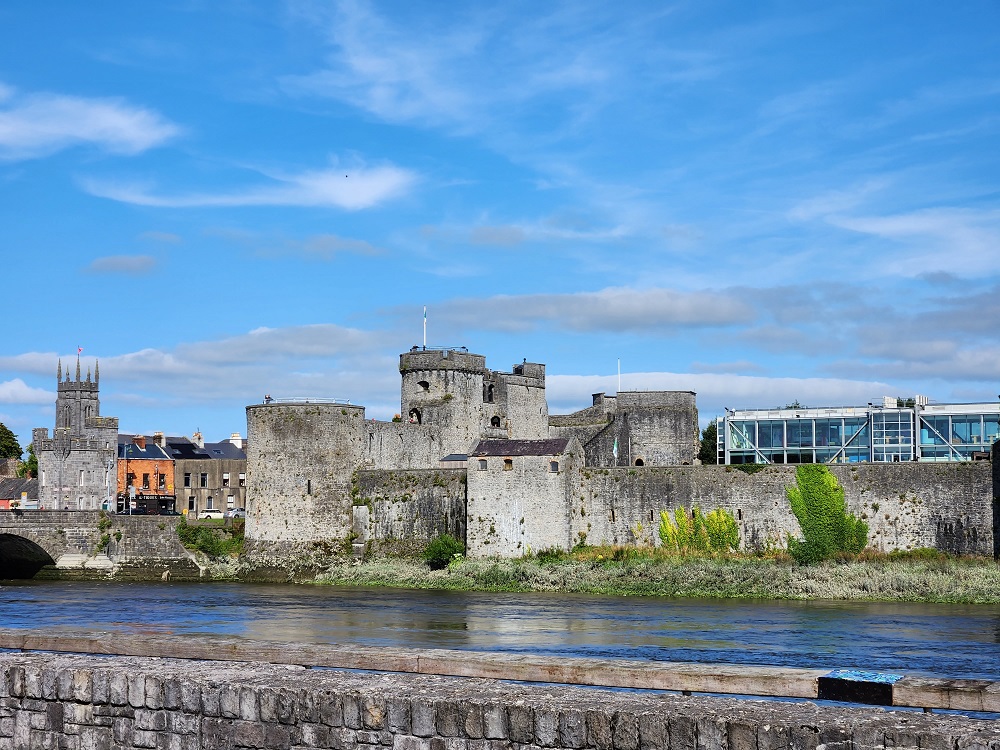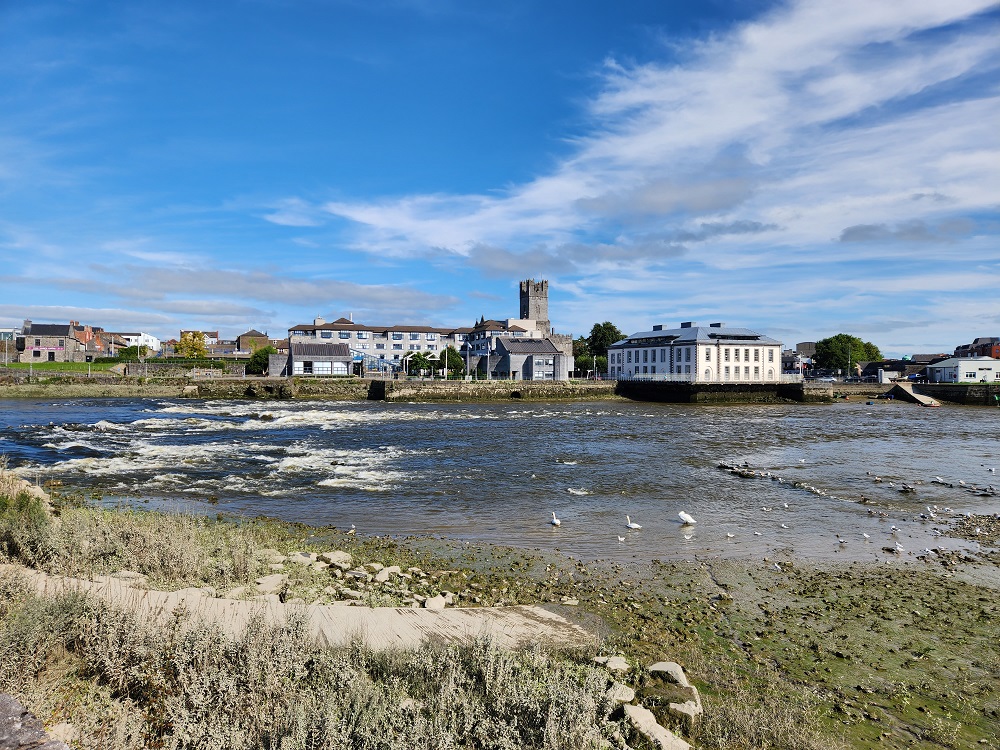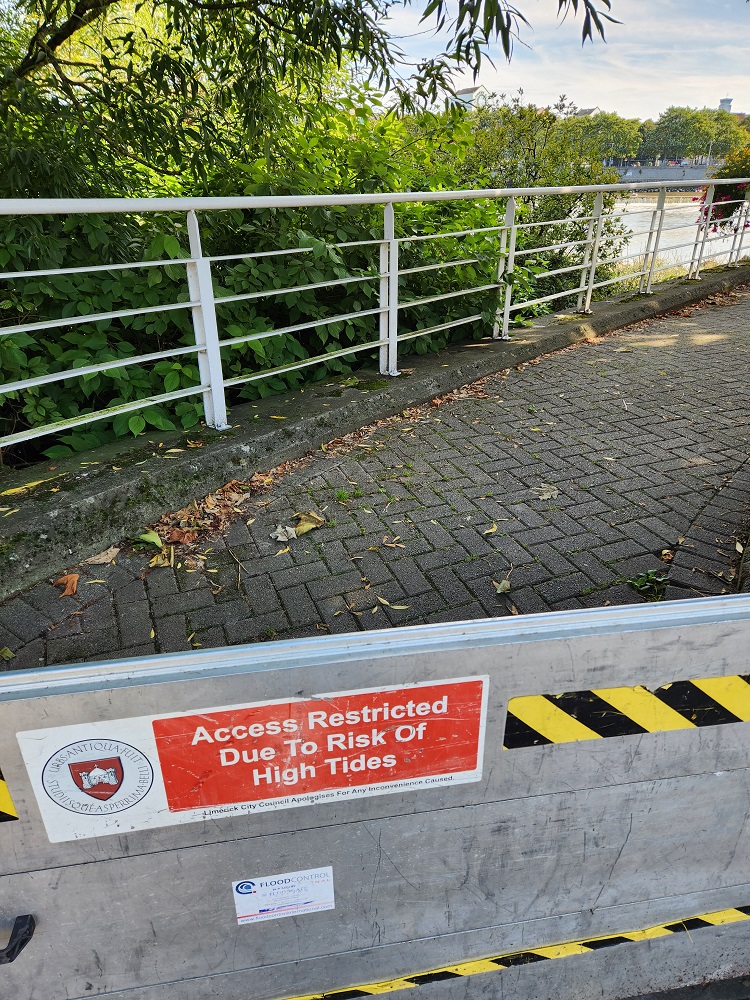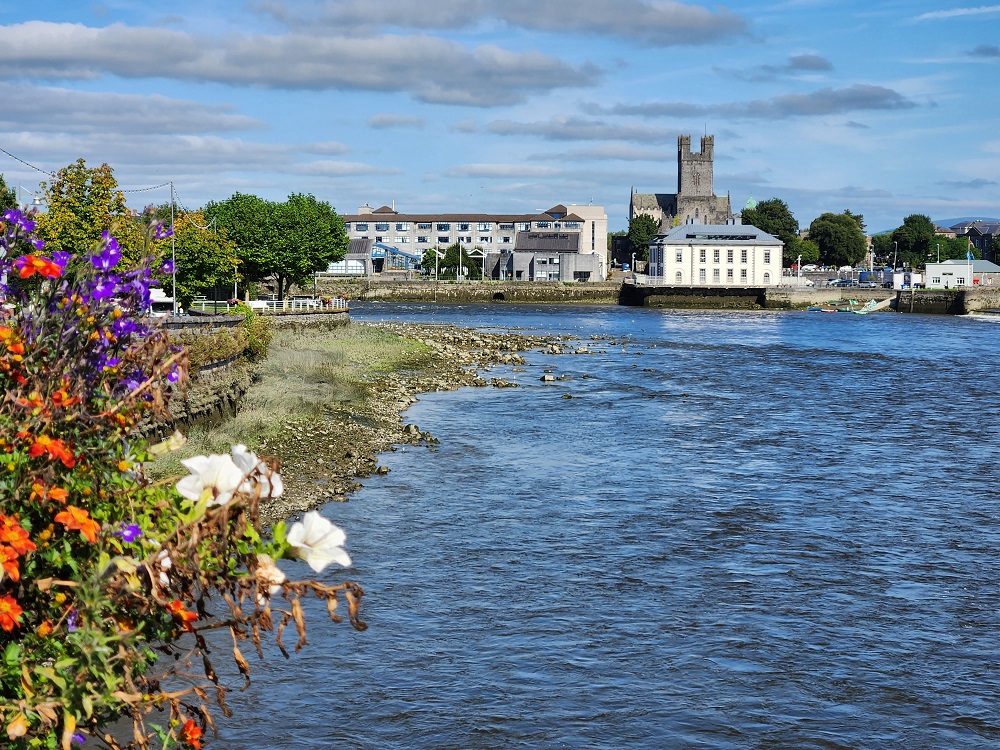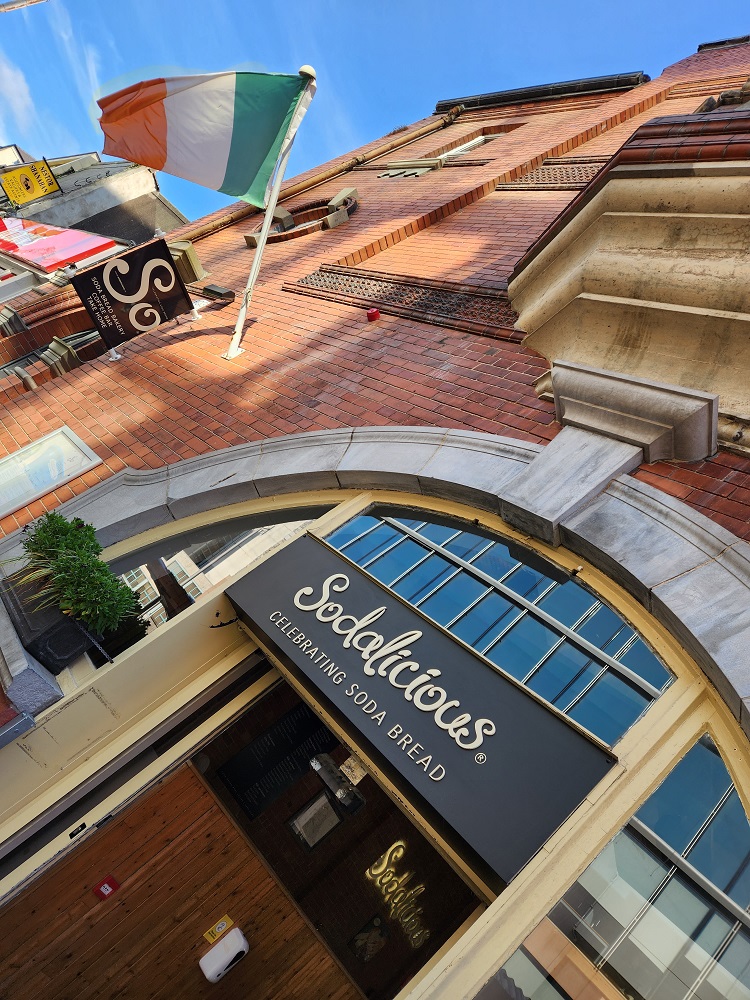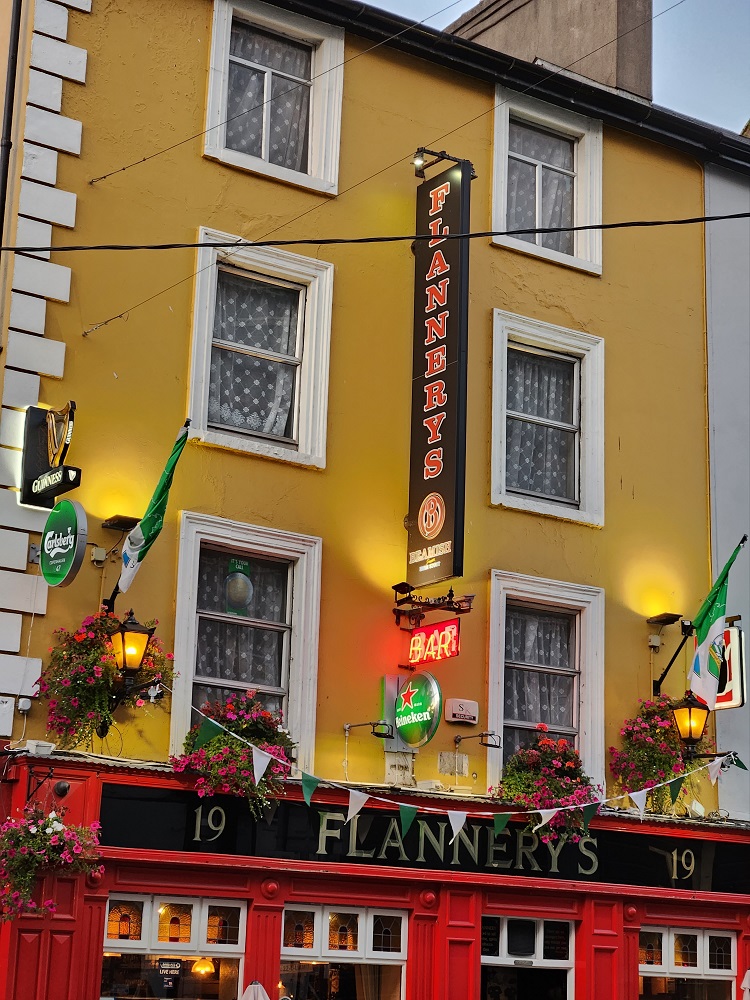We were quite slow getting out our first of two full days in Dublin. We had breakfast around 8:30am but then went back to the room and lazed about until nearly 11:30am. Finally headed out and toward Trinity College for our first destination of the day.
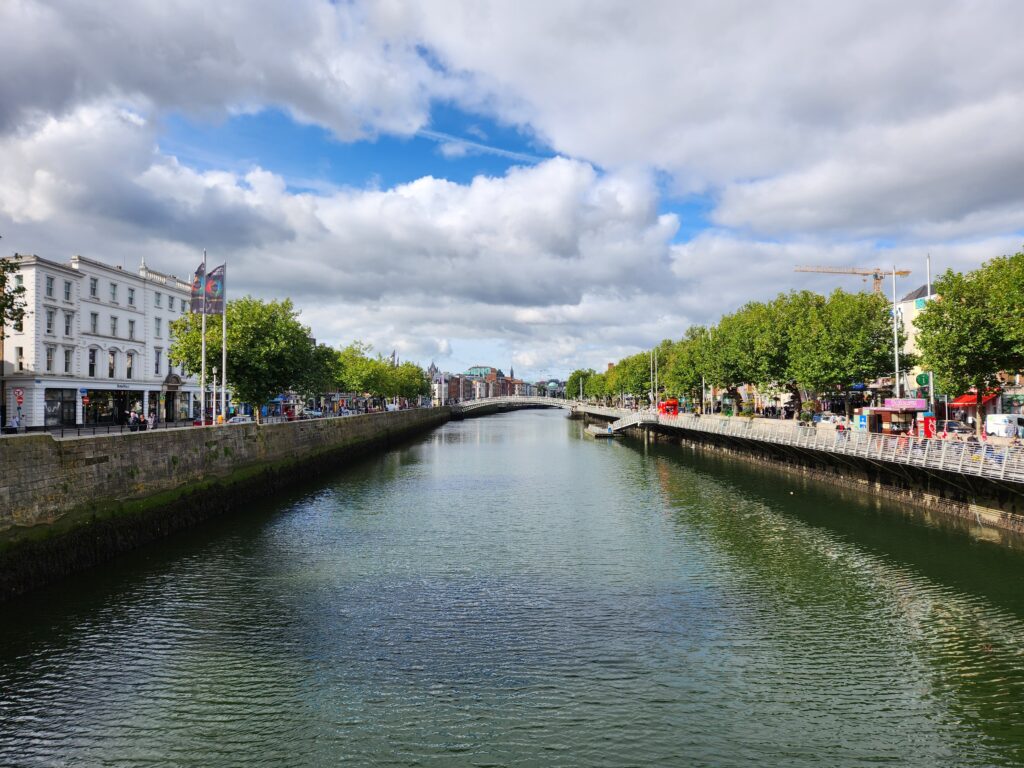
Trinity College has a beautiful old library called, appropriately enough, “The Old Library”. Within is the Book of Kells, a book from the 800s that I’ve always wanted to see. Once there we purchased tickets at 18.50 a pop using a QR code but our slot wouldn’t be until 1:30pm. With some time to kill we walked down Dawson Street toward St. Stephen’s Green, a beautiful park in south central Dublin from 1880. We enjoyed walking along the small lake (with tons of ducks and other birds) and standing on the stone bridge shown in the movie “Leap Year”. During the Easter Rising of 1916 some of the Irish Citizen’s Army took up a defensive position in the park but that was a mistake as the British were able to fire down onto them from a neighboring hotel. Eventually the defenders retreated but before that fighting was halted for a bit so that the ducks could be fed. Placards in the park described some of the events of that time.
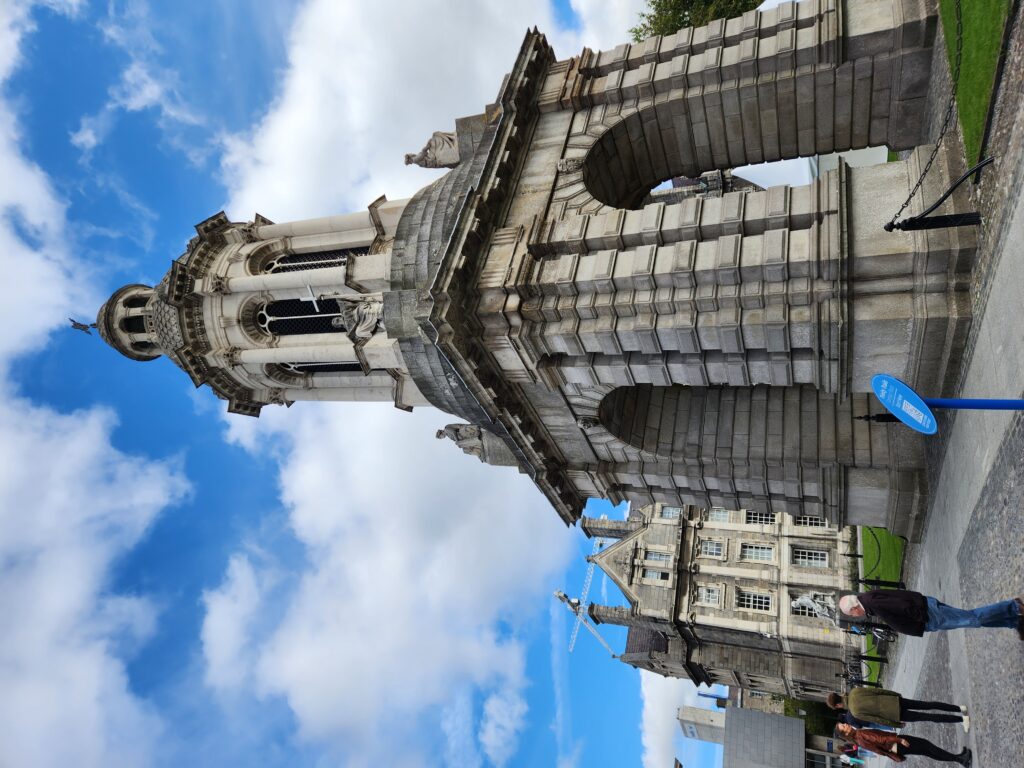
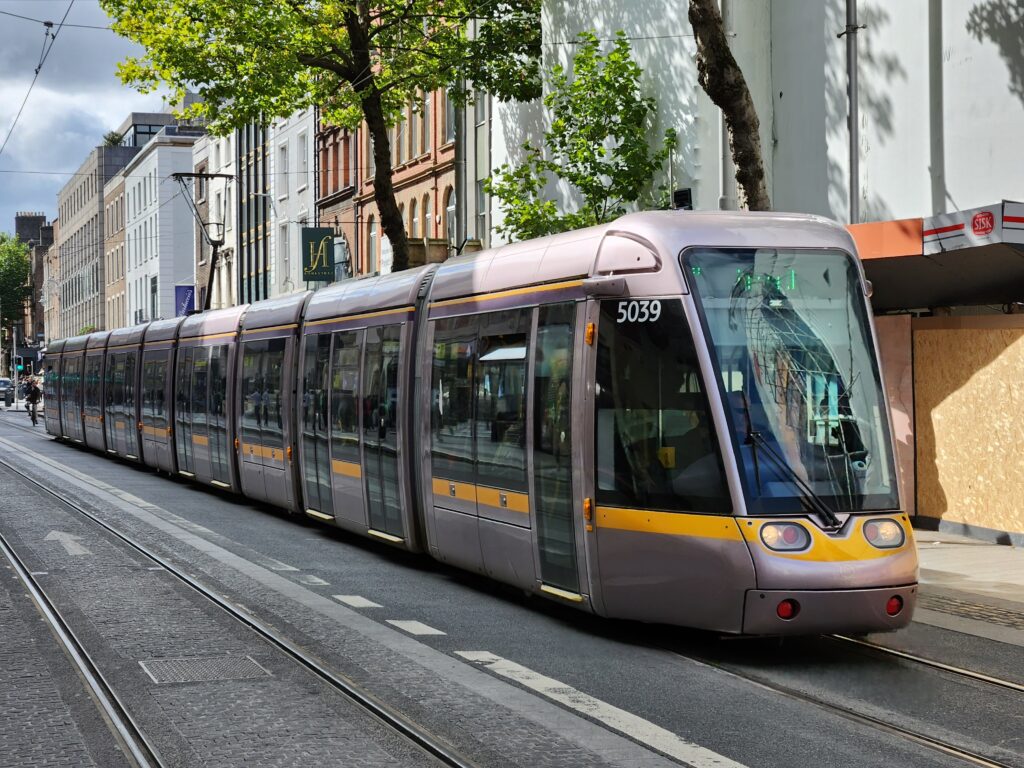
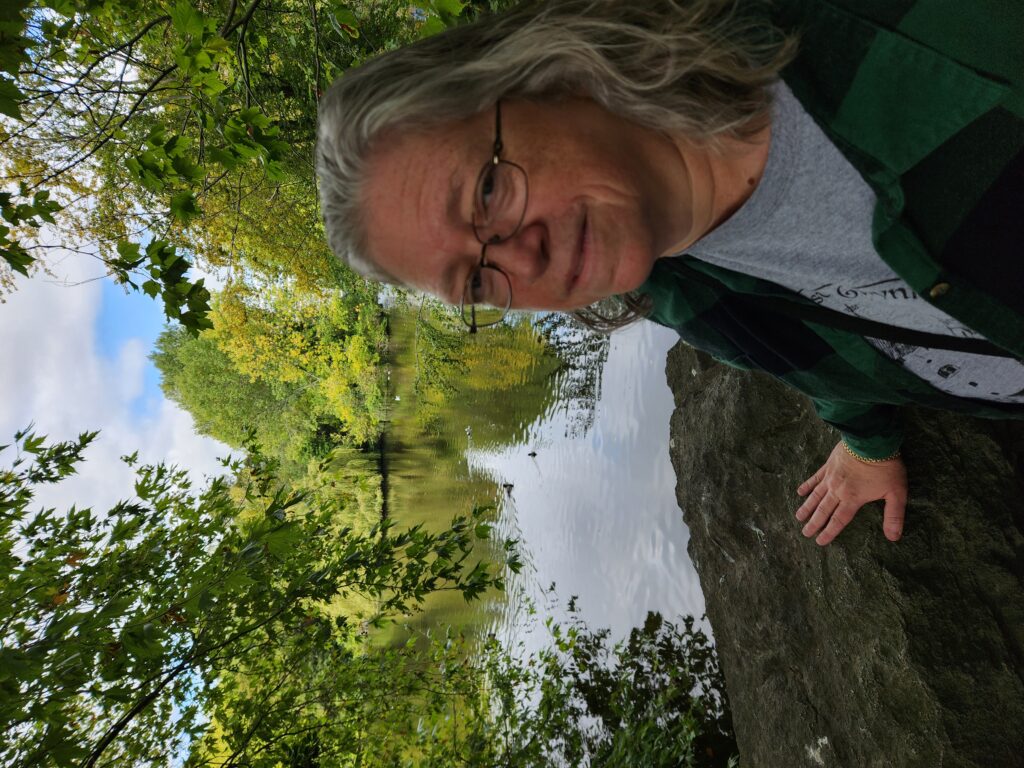
After the park we at at Milano on Dawson Street. We had a American pizza (basically pepperoni and cheese) in the Romana style (basically thin crust). Michelle continued walking toward Trinity College while I took a quick detour to check out Kehoes Pub, in use since the Victorian times and with many of the original fixtures.
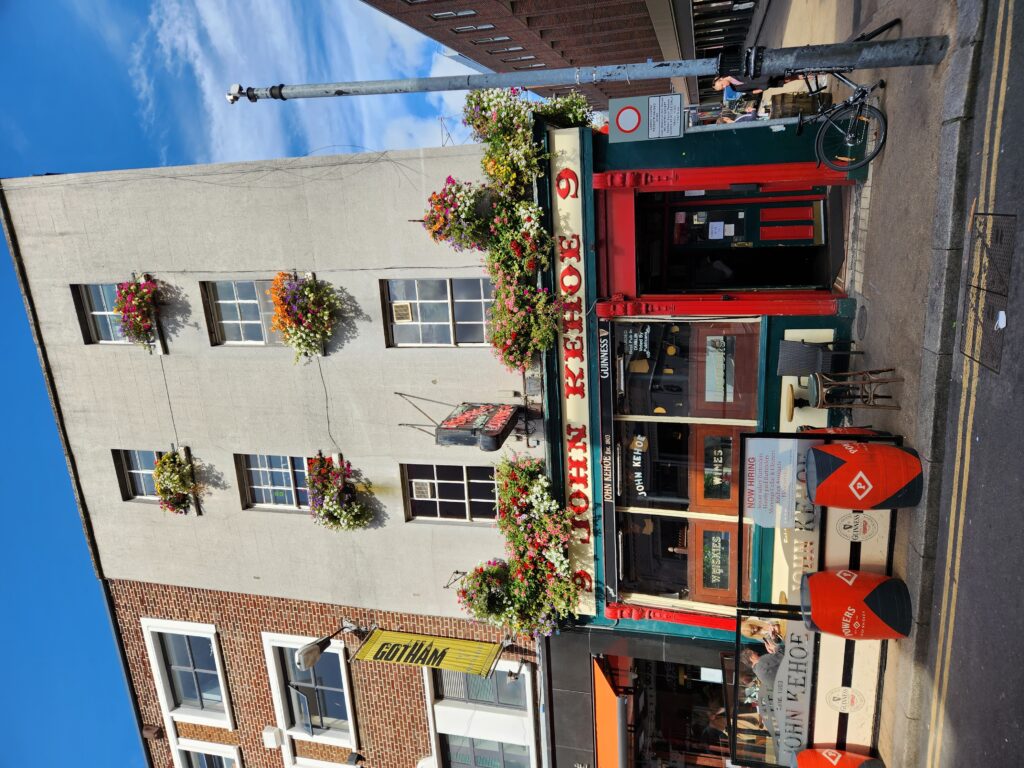
After freshening up we queued up for our 1:30pm entrance to the Book of Kells and The Old Library’s Long Room. There was an exhibit at the start filled with wonderful information about monastic life in 800s Ireland, other books like the Book of Kells, how the book was made (spoiler: over a hundred cows “participated” by contributing their hides), and the content of the book. What was really interesting is that there appear to be at least three illustrators at work with various specialties (lettering, animals & people, etc.).
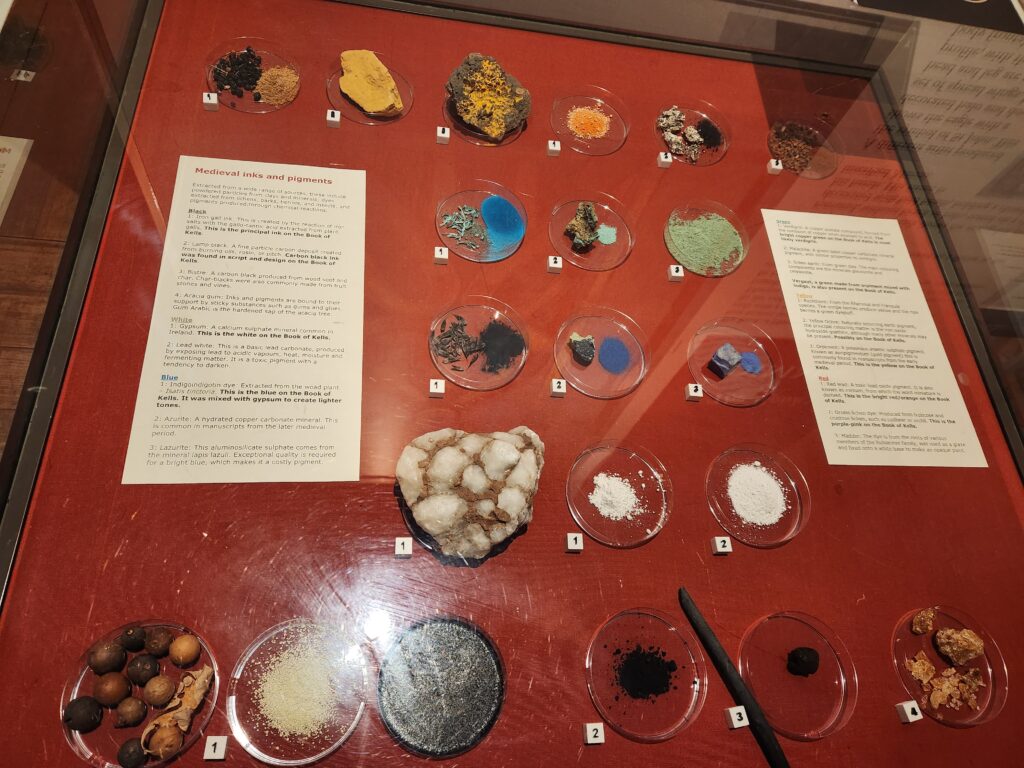
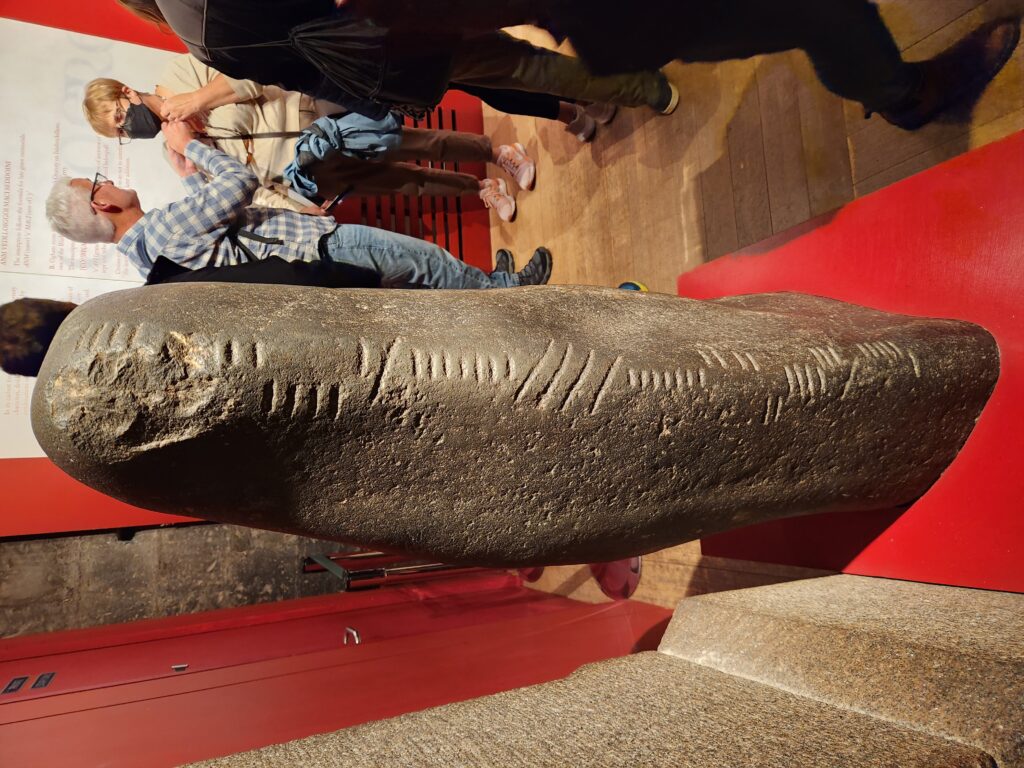
Once through the exhibit area we entered a small side room that was mostly dark and contained the actual Book of Kells in a glass cube enclosure. On the one hand, wow, a 1200 year old book! On the other hand, it was a little underwhelming in that it is open to only two pages (being a book). Someone expressed disappointment that the two pages were more words than illustration and he just replied that for every one that wants an illustration on display there’s another that wants words. I’m just glad we got to see it — on days when they turn to another place in the book the area is shut down for quite some time as many precautions must be taken to not damage the book.
Once leaving the little room we went up a flight of stairs into the very impressive Long Room of The Old Library. Completed in 1861 it was very impressive. Though originally one story it was later expanded to two due to the need to house more collections of books. Running along the length were busts of famous authors, philosophers, and the like. Each alcove contained books from floor to ceiling with ladders to access the high ones. There were beautiful spiral staircases providing access to the second floor but these were closed to tourists.
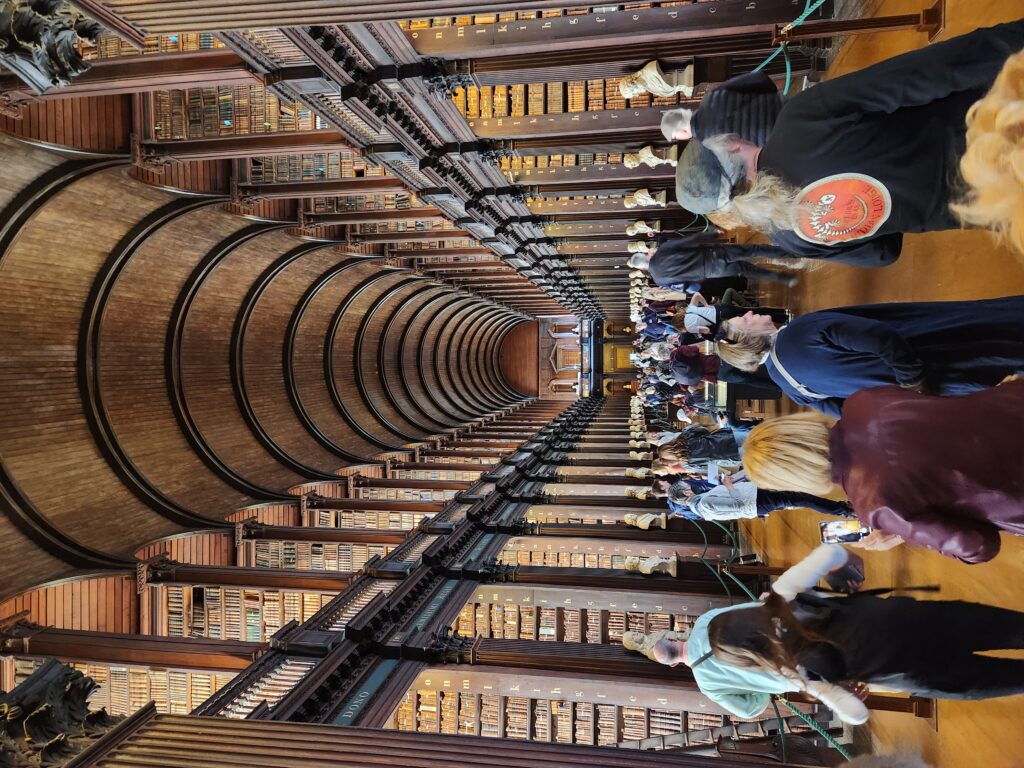
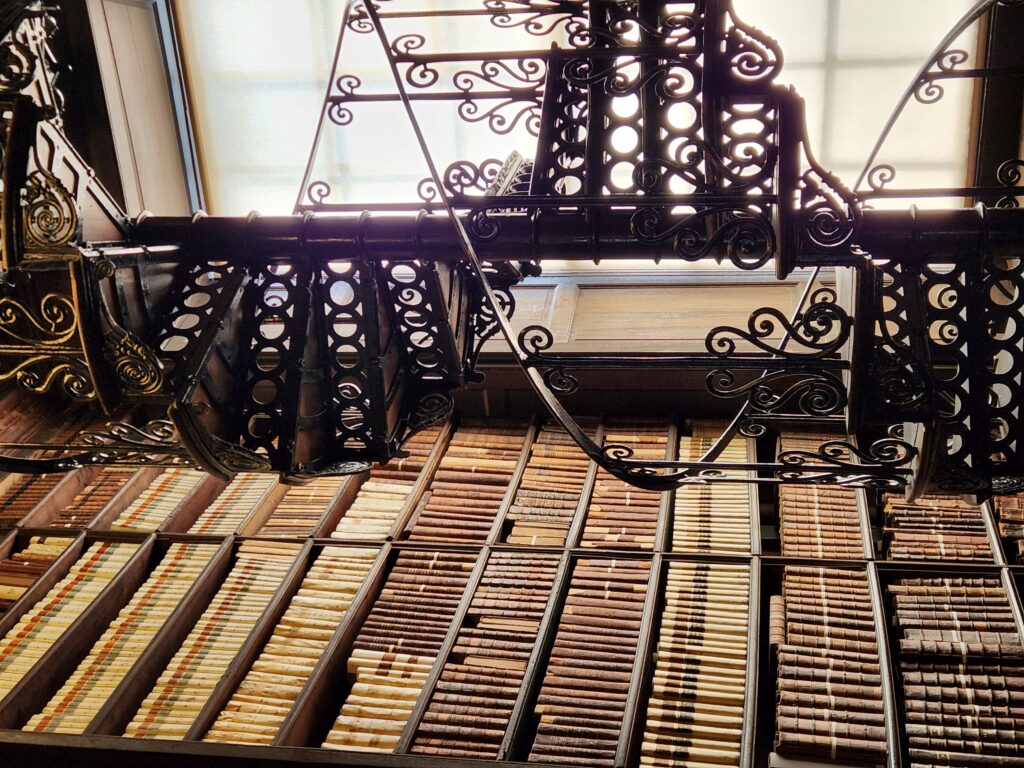
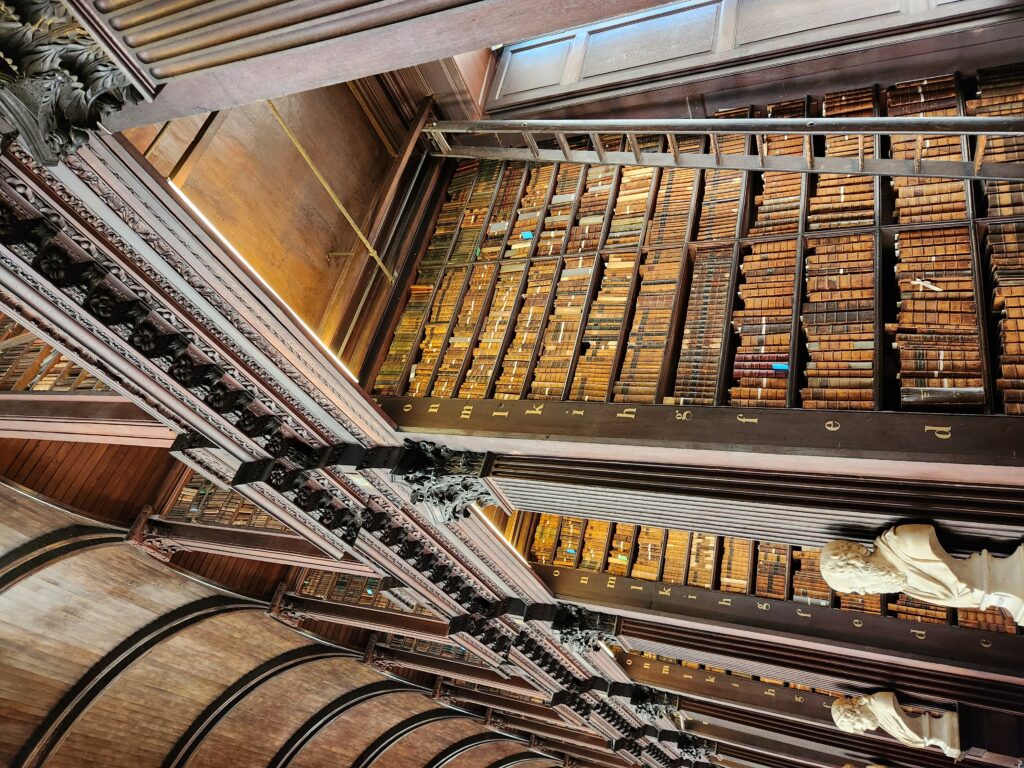
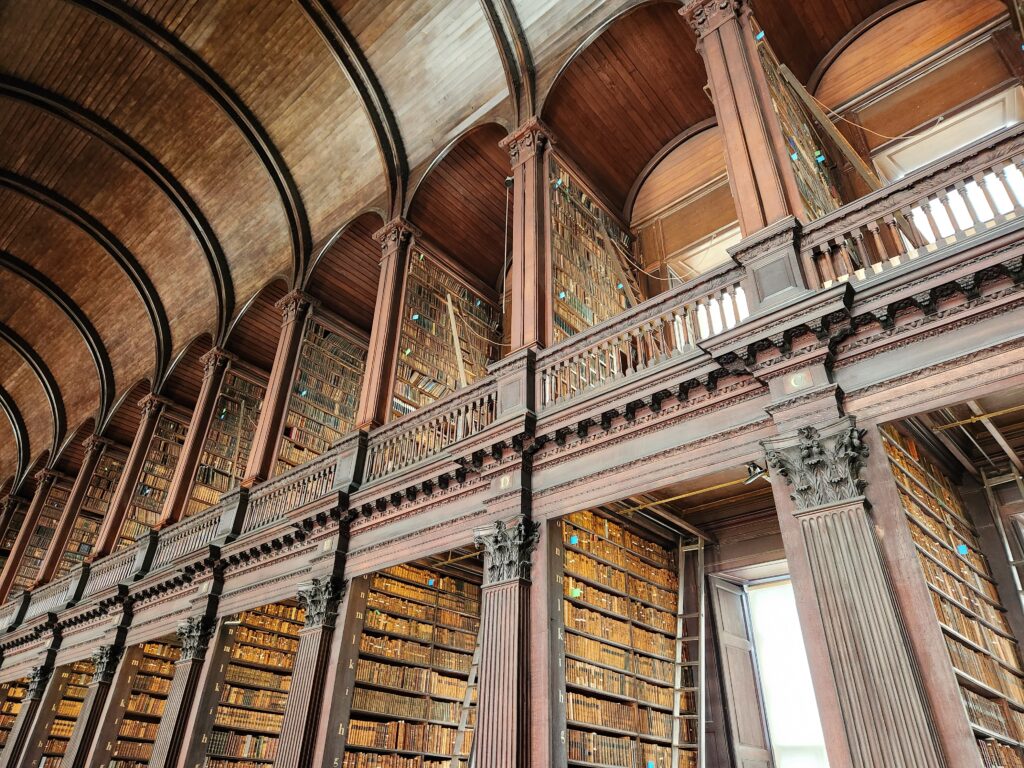
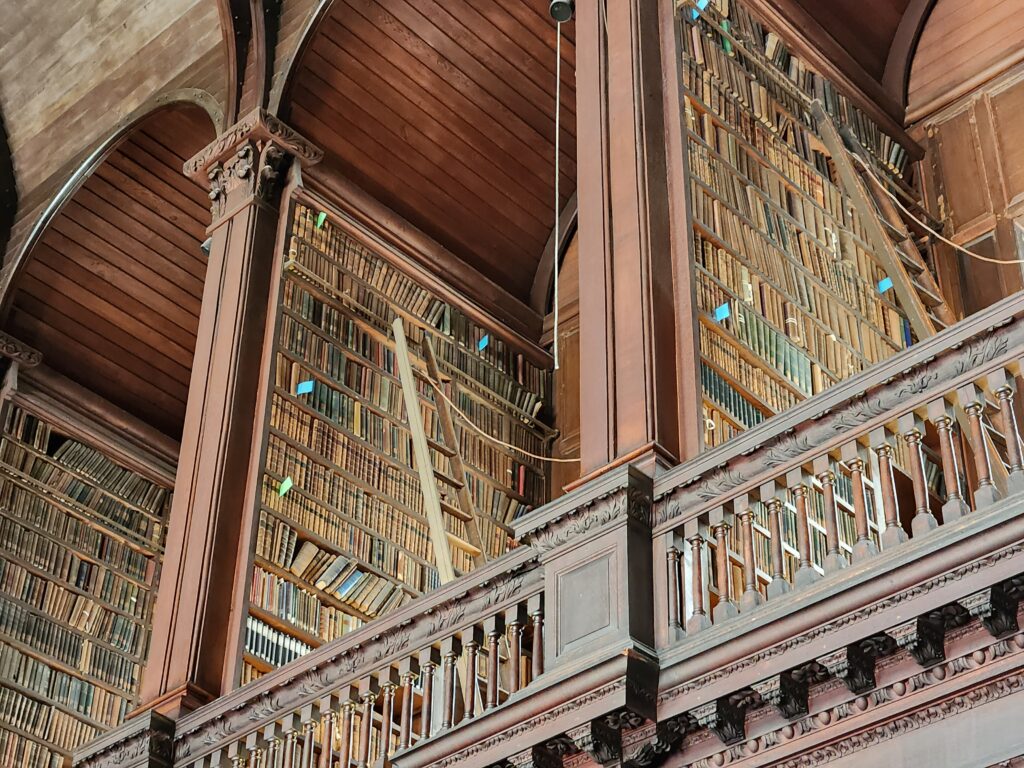
In the center of the room were some artifacts important to Ireland including the equivalent of our Declaration of Independence and a medieval harp, the oldest example in Ireland and the model for the harp that appears on their Euro and in other official places. Though it is called “Brian Boru’s Harp” it isn’t — he lived in the 11th century but the harp is either 14th or 15th century. Still old, and very beautiful.
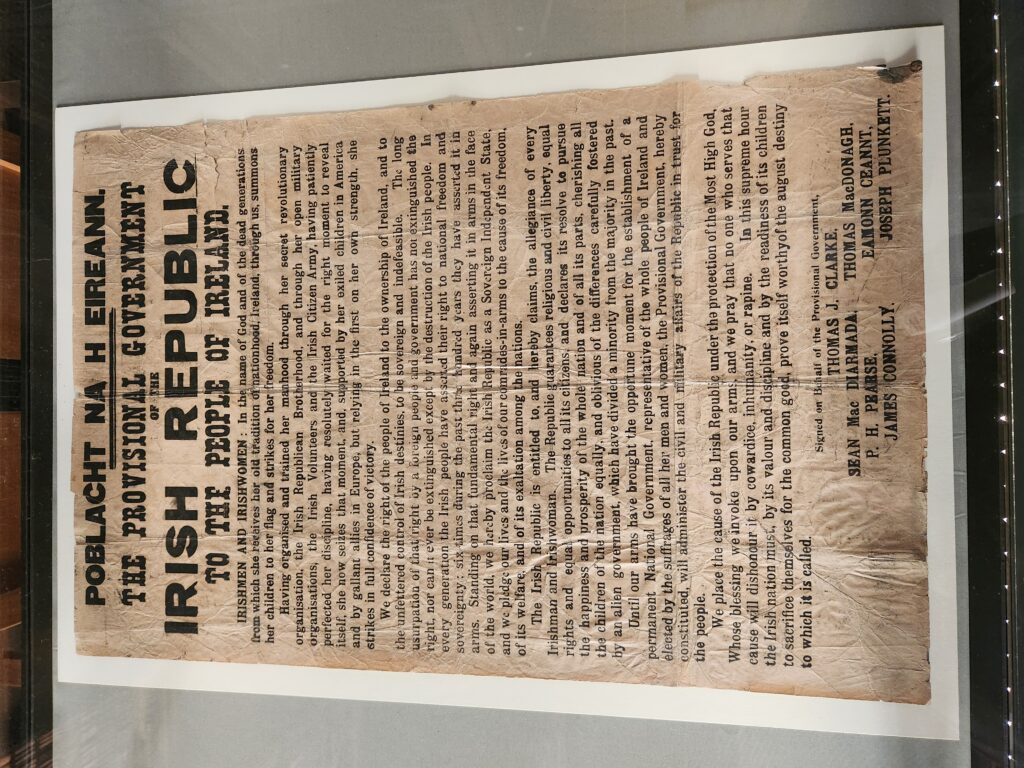
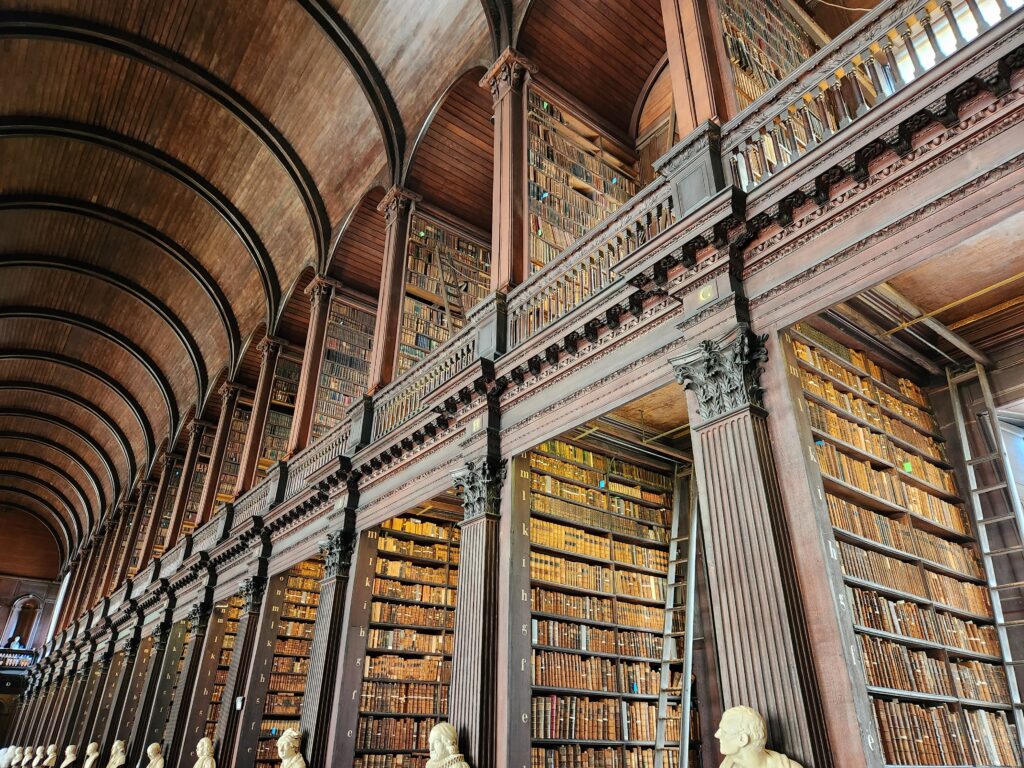
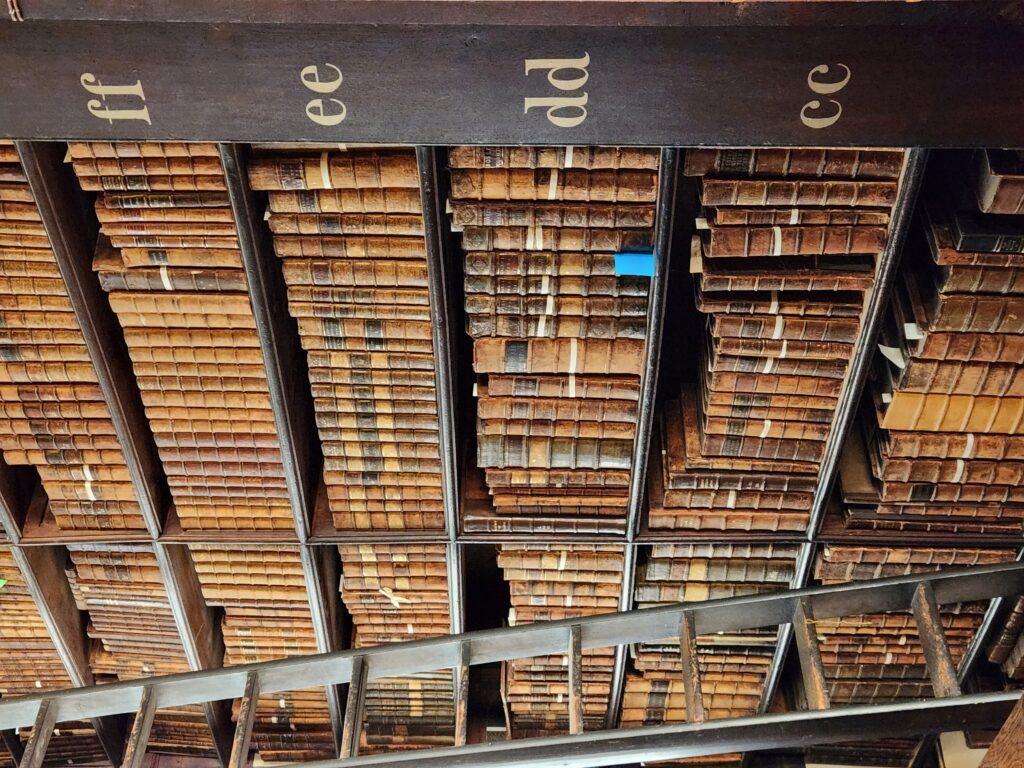
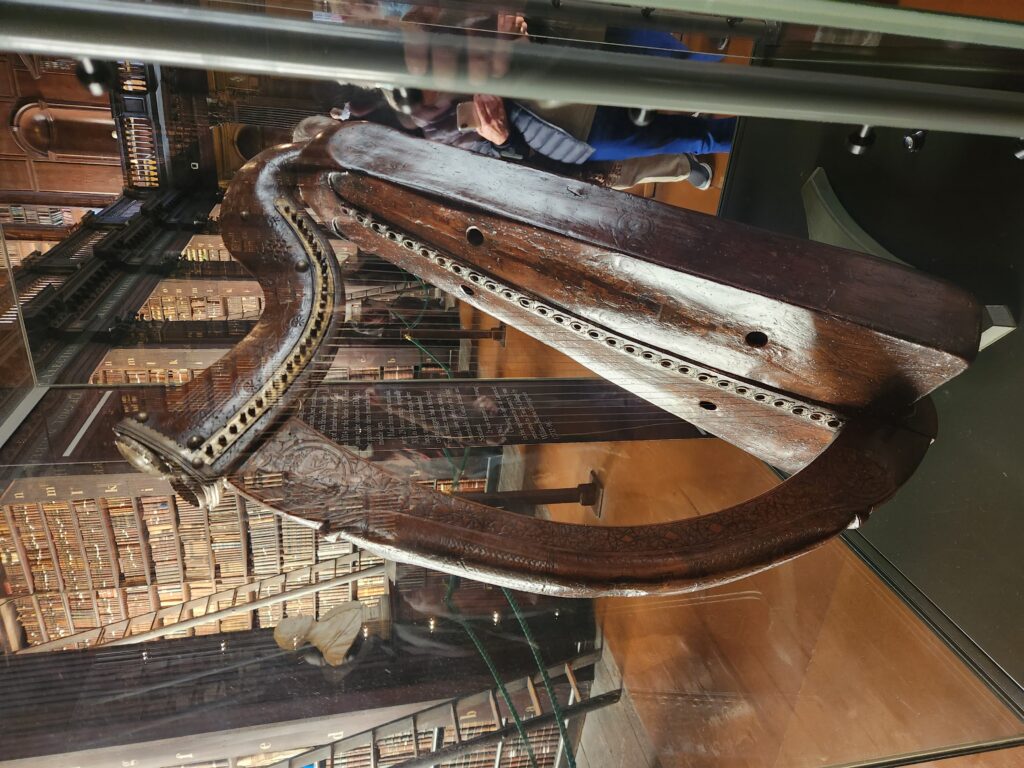
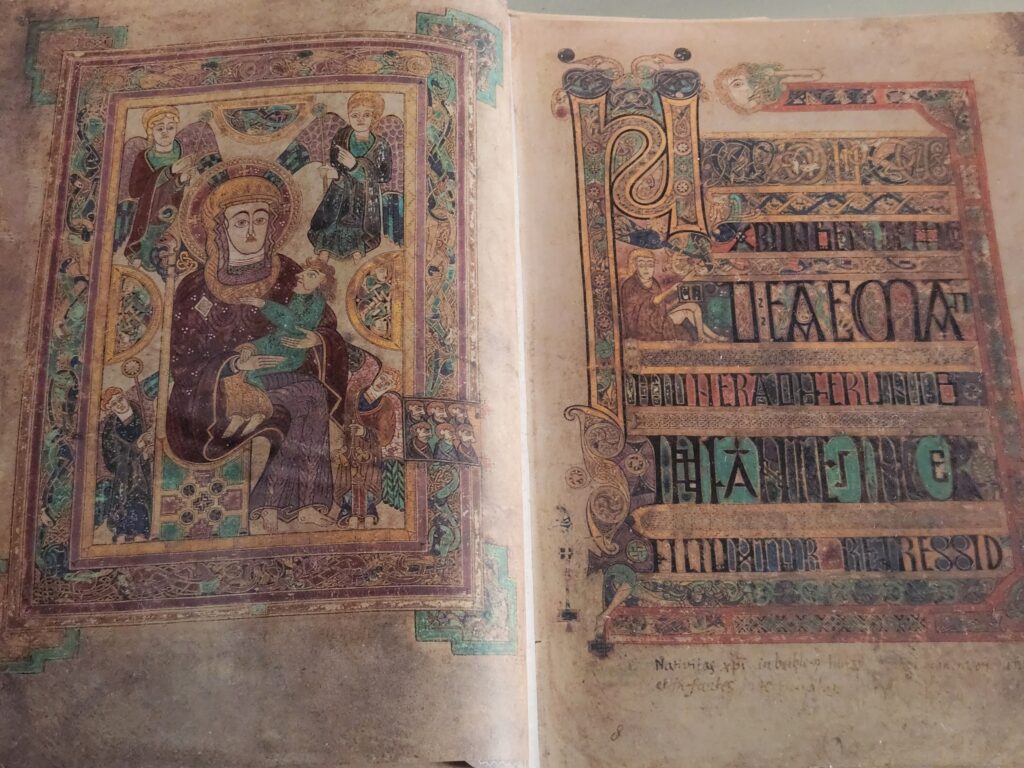
We descended a set of stairs that led through a gift shop. Buying our obligatory magnet we emerged into the pleasant Dublin afternoon. We went into a store selling Irish wool and other goods. Michelle found a new change purse and billfold (her existing ones being a bit frayed). While there a lady and girl go to the side of the counter and the guy at the register turns to his co-worker (and by the looks of it, manager) and says “let me introduce you to the most important woman in the world, me mum.” It was really sweet.
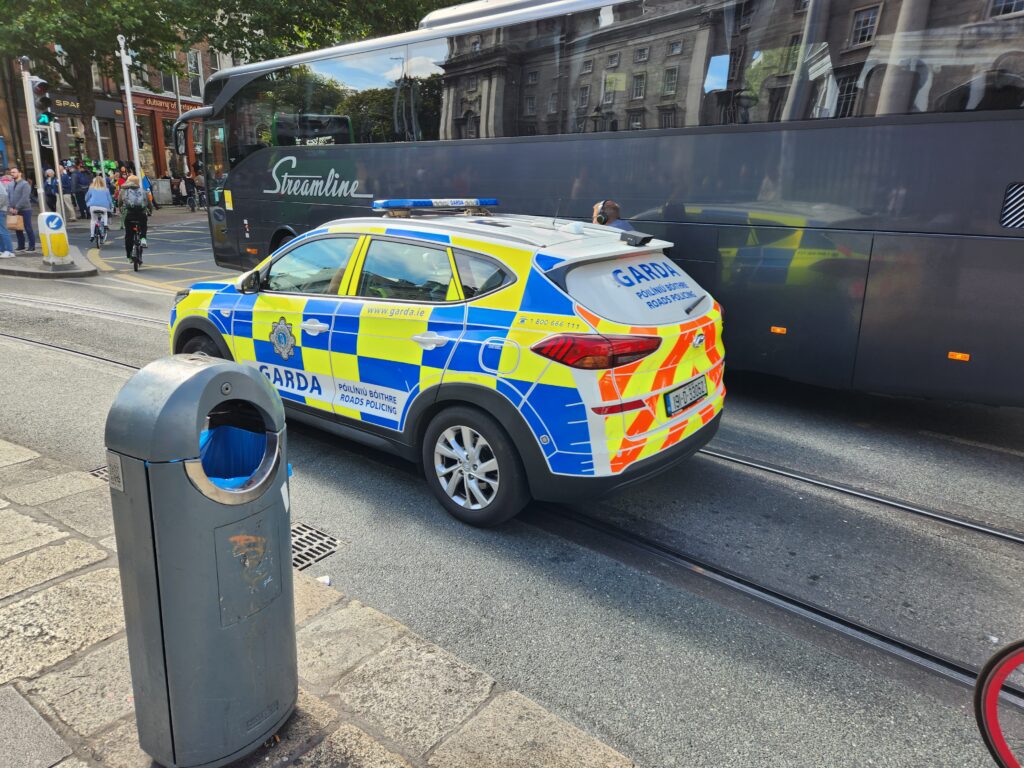
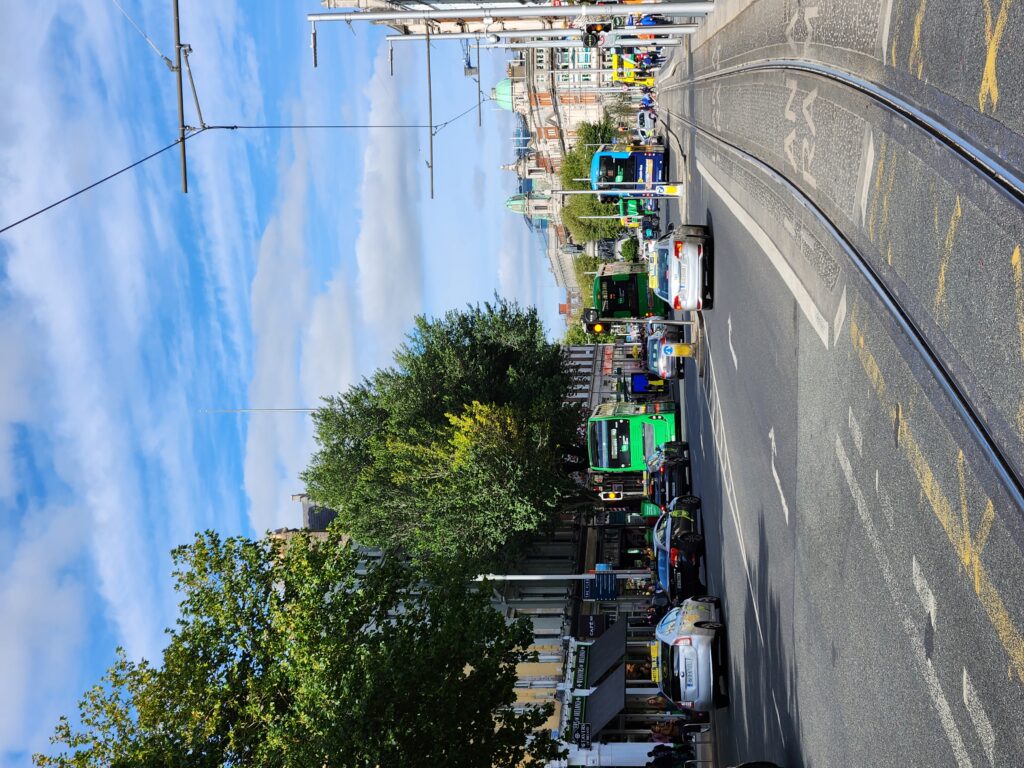
As Michelle still wasn’t feeling great we decided to swing by the hotel room via the O’Connell Street bridge. I bought some Maltesers, the European version of Whoppers (malted milk balls). I lingered a little bit to ensure she was situated and headed back out into the town around 3:30pm. I first swung by the Games Workshop and Gamers World. Sadly, much like Forbidden Planet, just the stuff you find at home. I was amused to see a Harry Potter Cluedo (as Clue is known as overseas). I then headed across the Millennium Bridge and into the Temple Bar, turning west towards Dublin Castle.
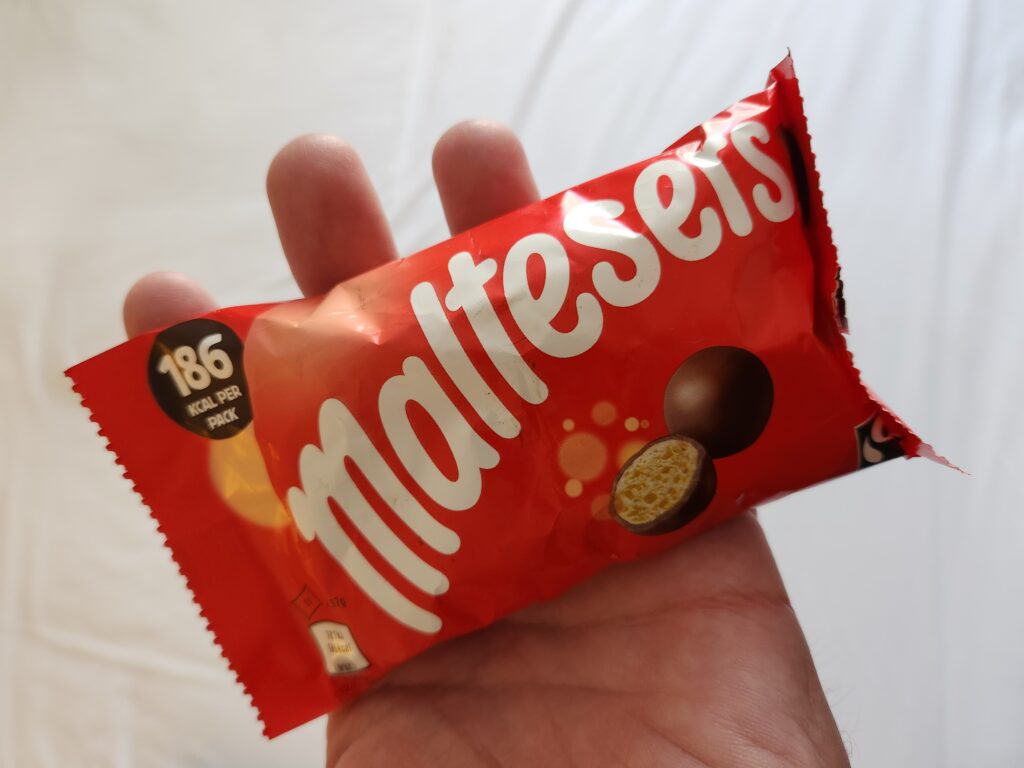
Dublin Castle was built during the time of the first Norman presence in Ireland so, like King John’s Castle in Limerick, built in the late 1100s and early 1200s. As this castle served as a working capital / palace for nearly a thousand years it, unlike King John’s, has undergone extensive modification (read: boringification). The only bits that remain from the original castle are two towers and one of those was under scaffolding being renovated. There was a pretty park adjacent to the castle as well as the Chester Beatty. But museums weren’t on my list today, onwards I went!
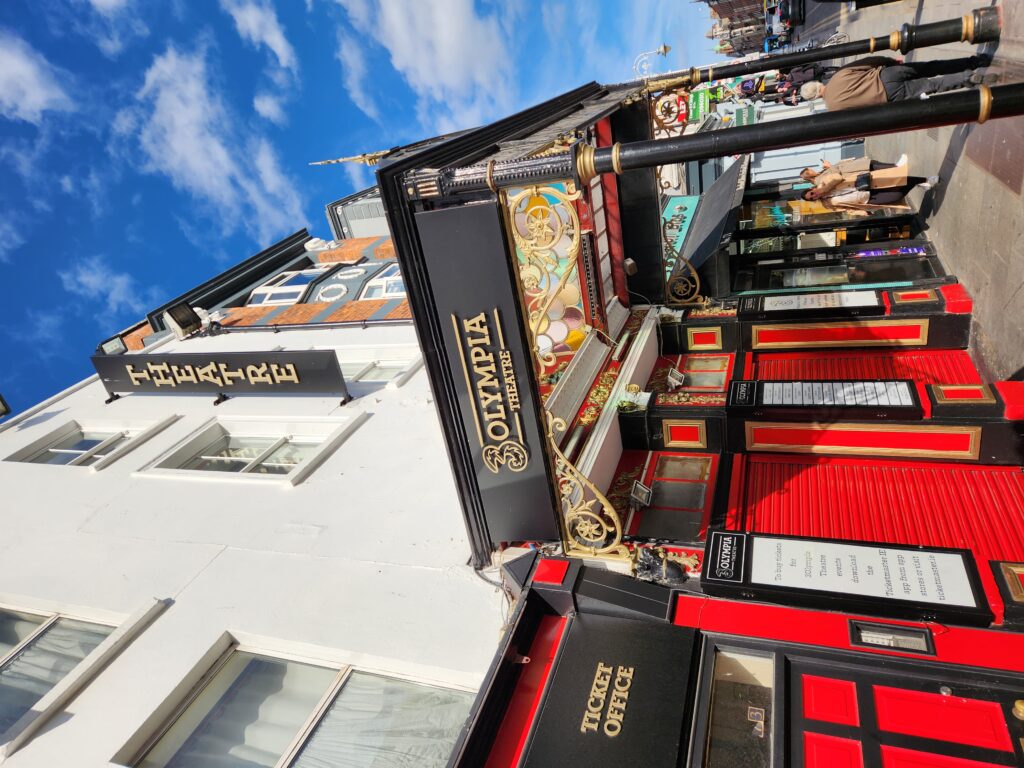
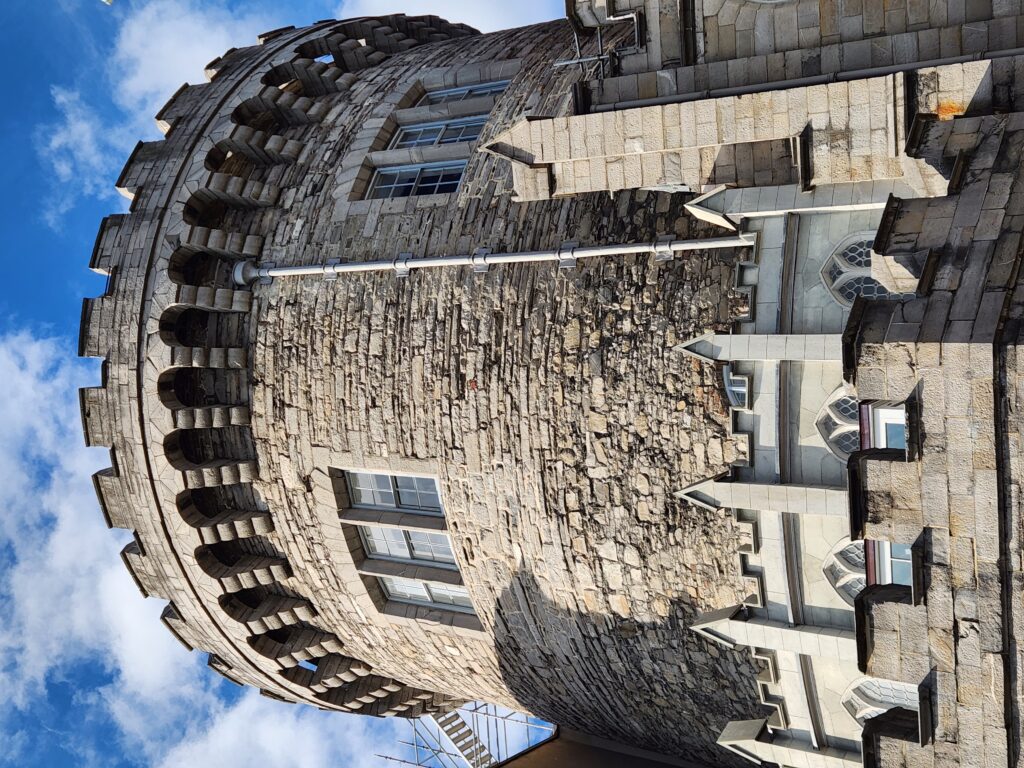
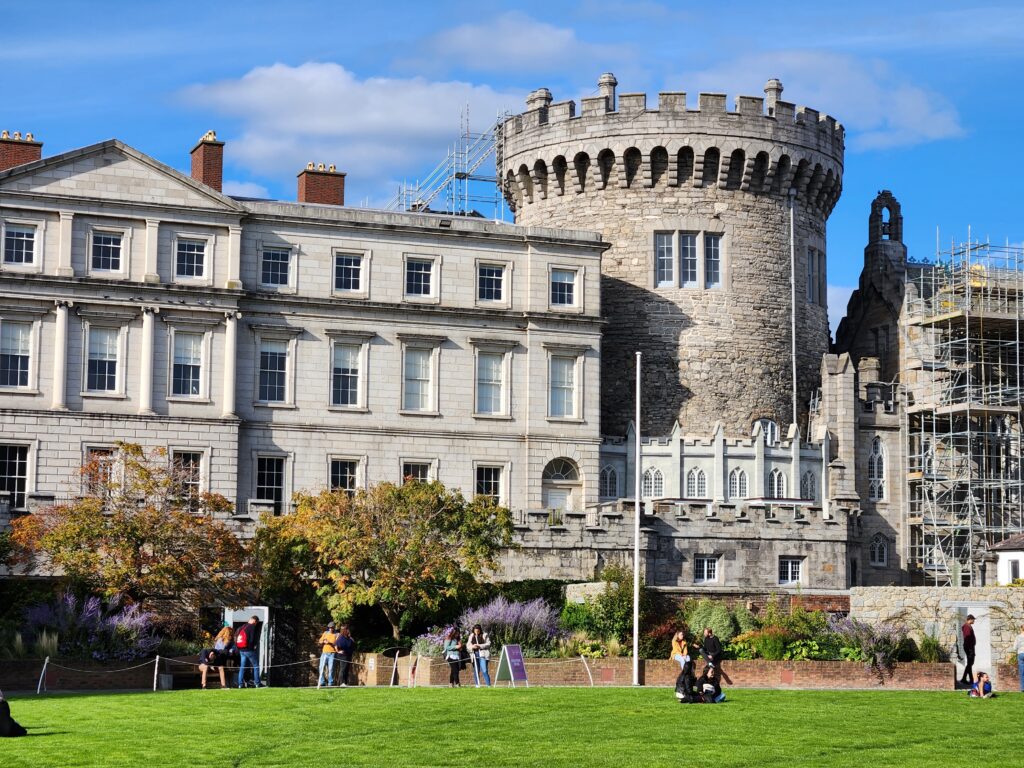
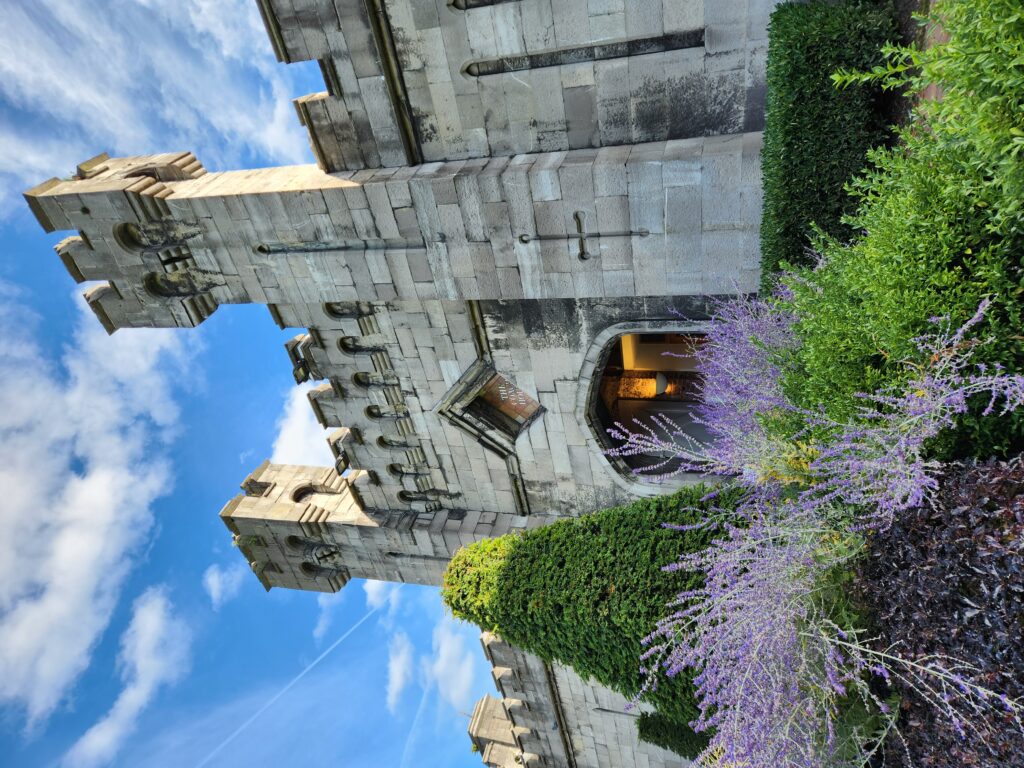
Continuing to the west-northwest I came upon Christ Church Cathedral. The first cathedral on the site was actually built by the Vikings in the early 1000s. The Normans rebuilt it in stone in the late 1100s under the direction of the leader named Strongbow (ok, best name ever). I just took a few pictures, though. If I’m being honest I’m a bit churched out from past trips and the pictures on Google Maps didn’t inspire me to go in. They did have some crypts you could go into as well as a mummified cat and rat found in an organ, but… ick. There were metal flagstones in the sidewalk showing Viking artifacts to highlight that this part of Dublin was the site of the Viking settlement (and draw the tourist into Dublinia, a Viking “audo-visual experience”, no doubt). Regardless, I resisted.
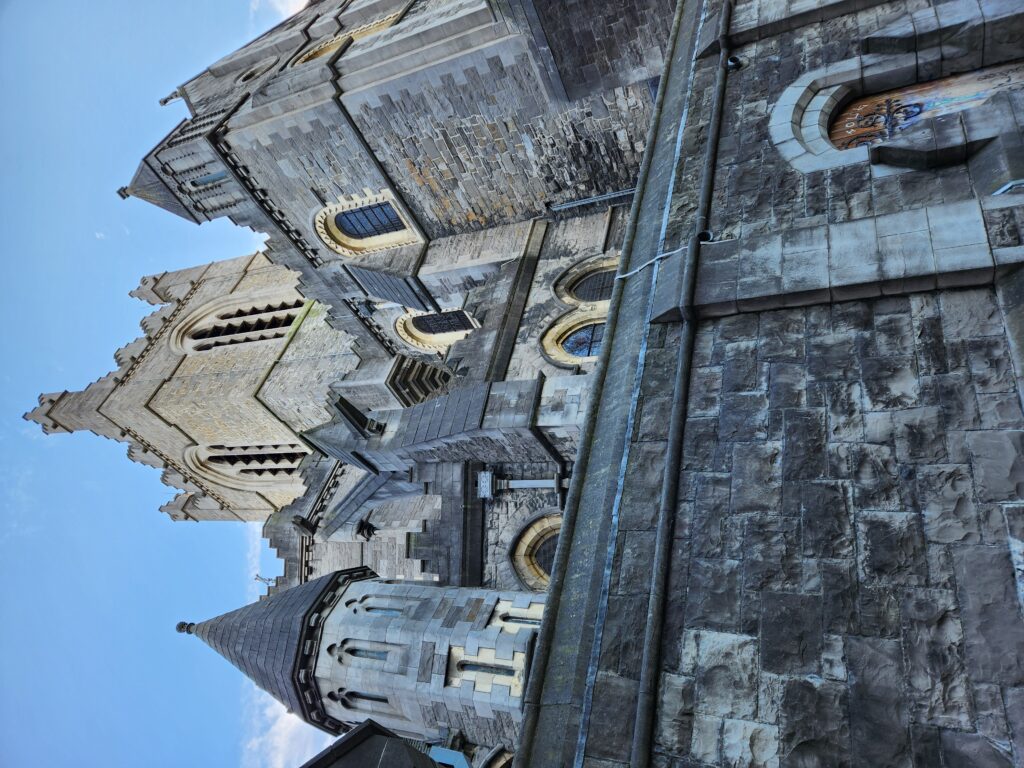
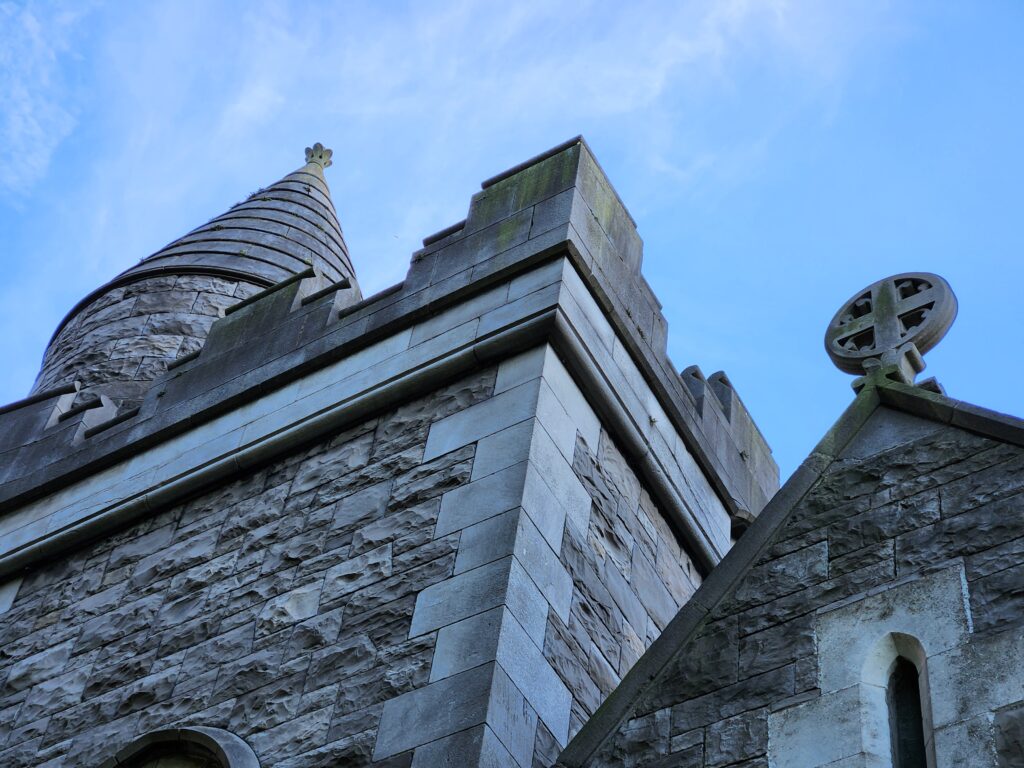
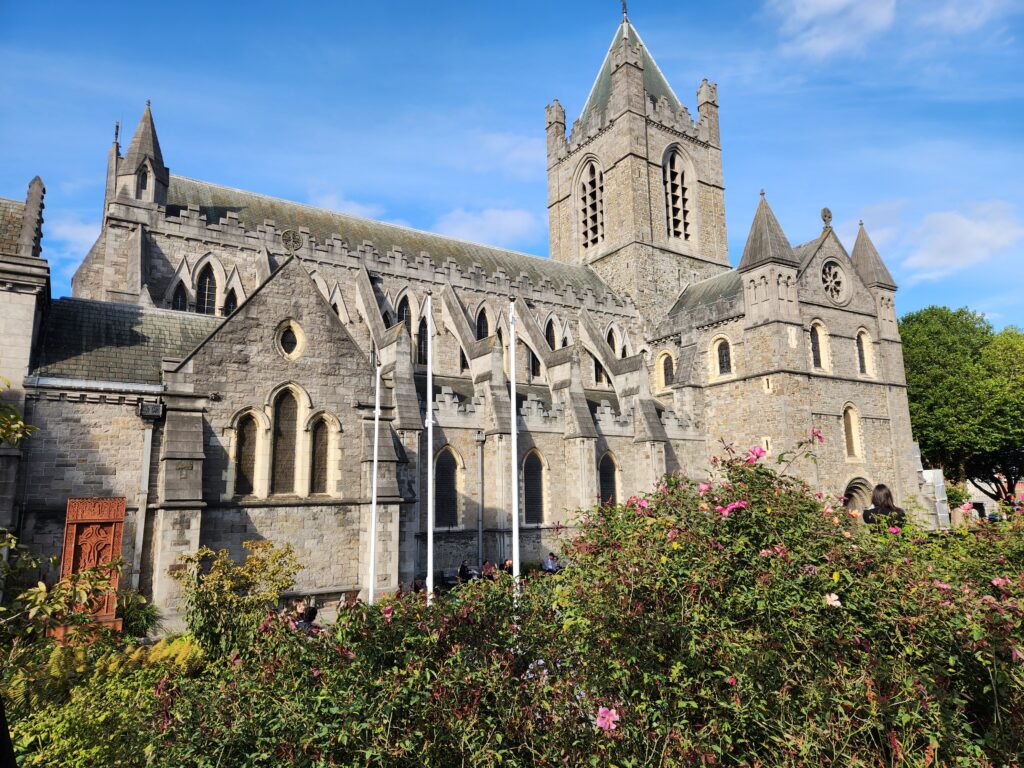
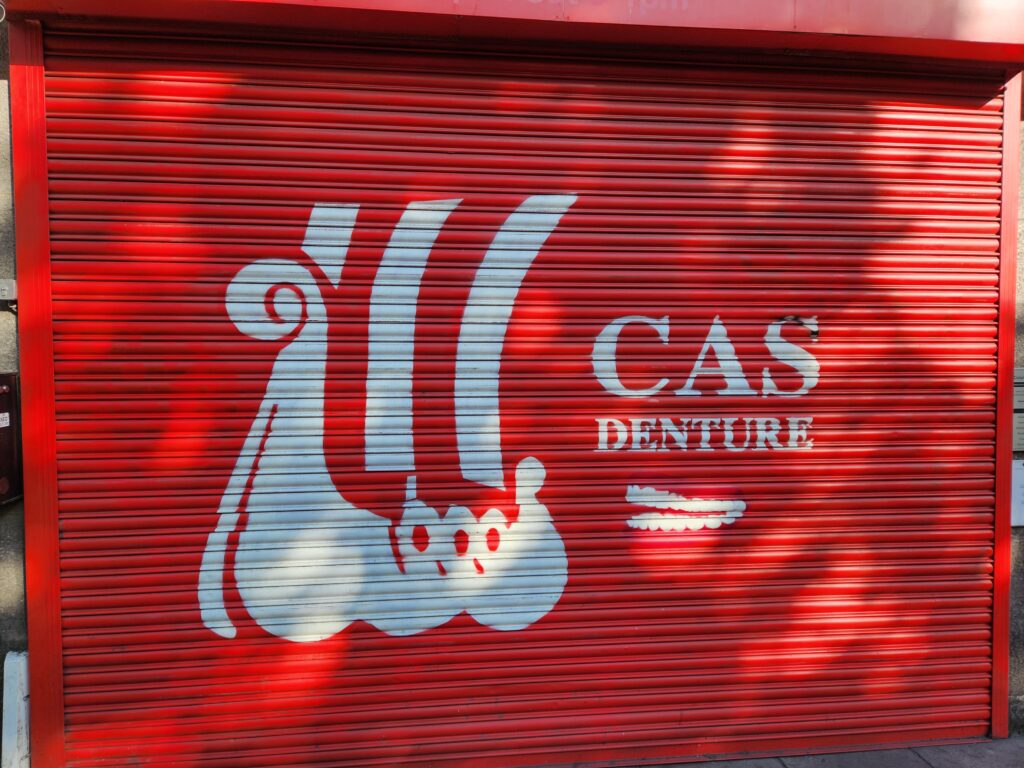
So onwards I went, turning due south towards Dublin’s other (and slightly younger at 1191) cathedral, St. Patrick’s. Two cathedrals in one city?! Yep, and it was quite an issue for awhile until a complicated agreement was hammered out in 1300. Even today, Christ Church is the cathedral for the arch-diocese (being the first established) but St. Patrick’s is the “national cathedral of Ireland.” Regardless, pretty church indeed but, like Christ Church, not a ton to compel me to enter. The park adjacent to it, like Dublin Castle’s, was amazing — so lush and green. Reminded me of the grass you’d see up in the northeastern US.
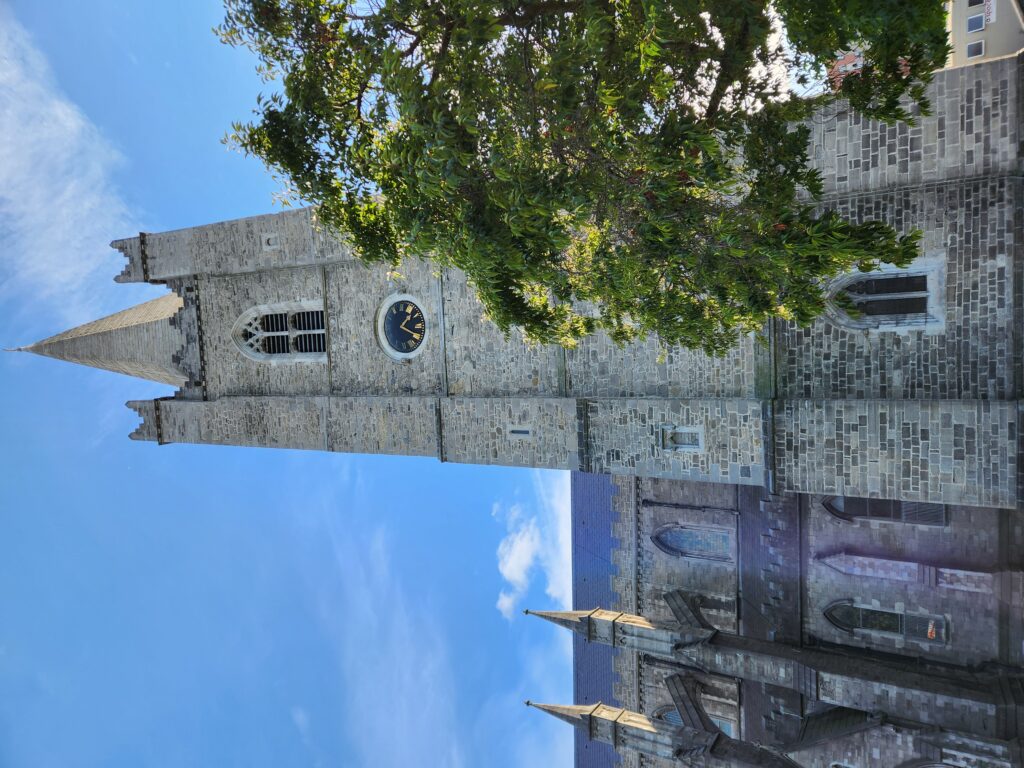
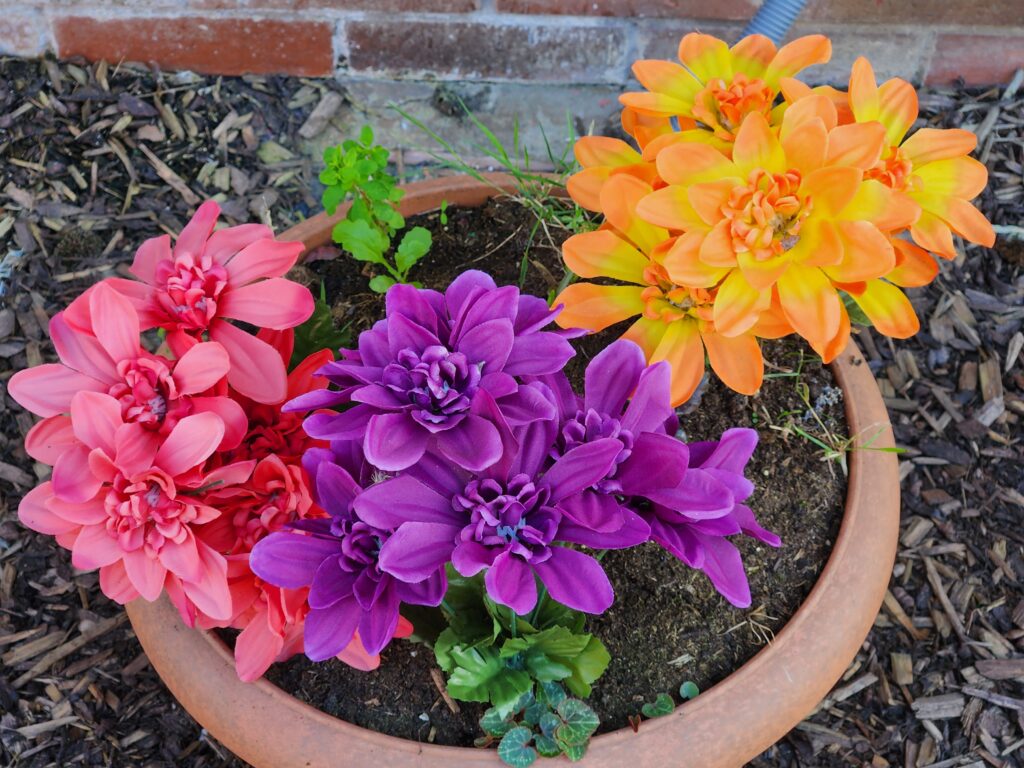
Turned east and headed to Grafton Street, the main shopping artery of Dublin. Well, mostly tourists shopping, this is where they went when not in Temple Bar drinking. Due to Garth being in town a fair number of cowboy hats. It was kind of unsettling, seeing so many people in cowboy hats and boots in frickin’ Dublin, Ireland. I stopped by the LEGO store. Unbelievably, there was a line to get in. I really just wanted a little something Irish in LEGO and the usher in front suggested building a minifig with an Irish football jersey. Sounded good. Except the line for that was enormous so oh well. Thought about just buying a single green 2×3 brick but decided they’d probably look at me like I was bonkers. They did have a few Ireland-specific builds on display — a stadium, the giant cooling towers, and a neat diorama with a Viking and a musician. So I took some pictures and scooted out.
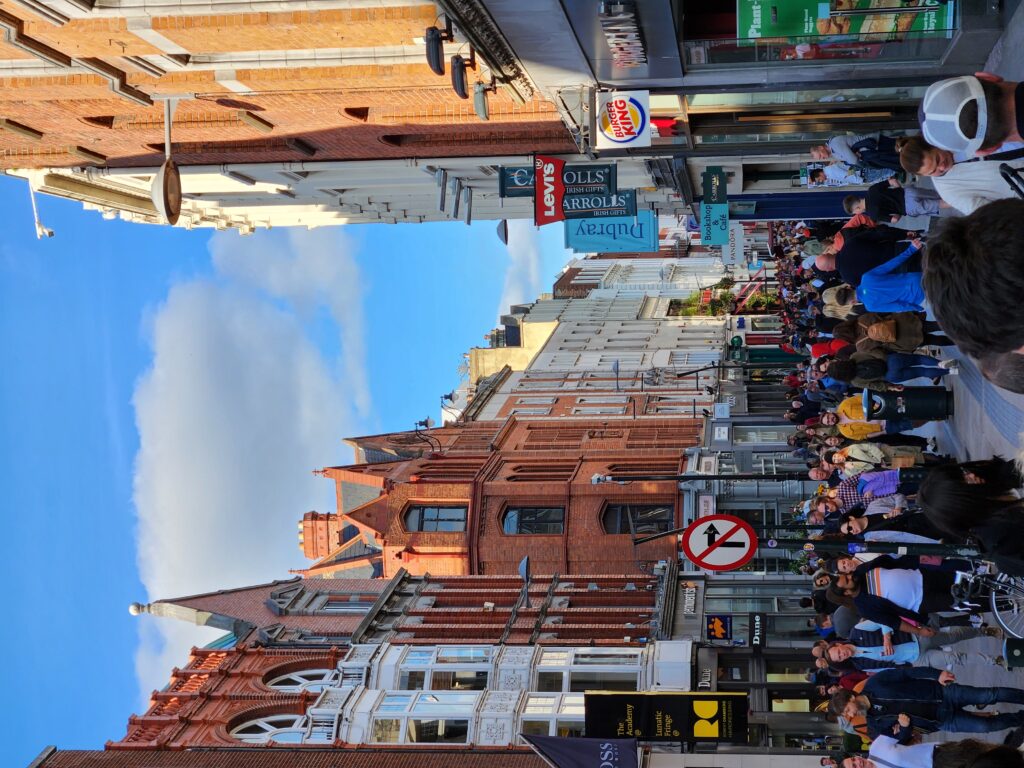
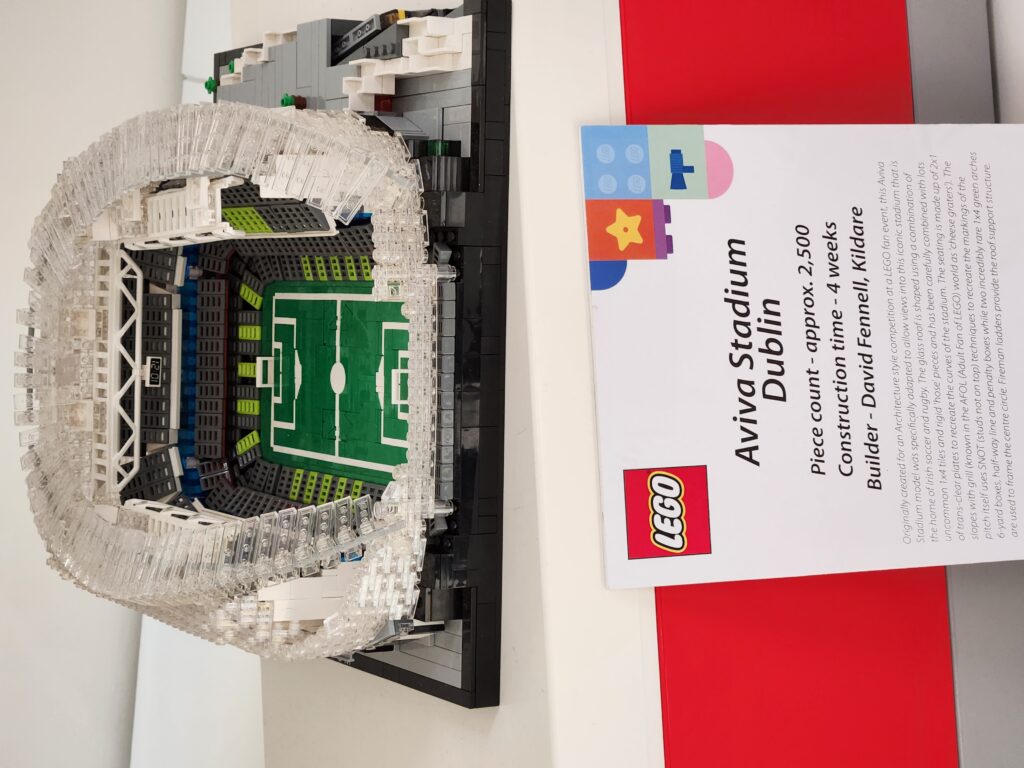
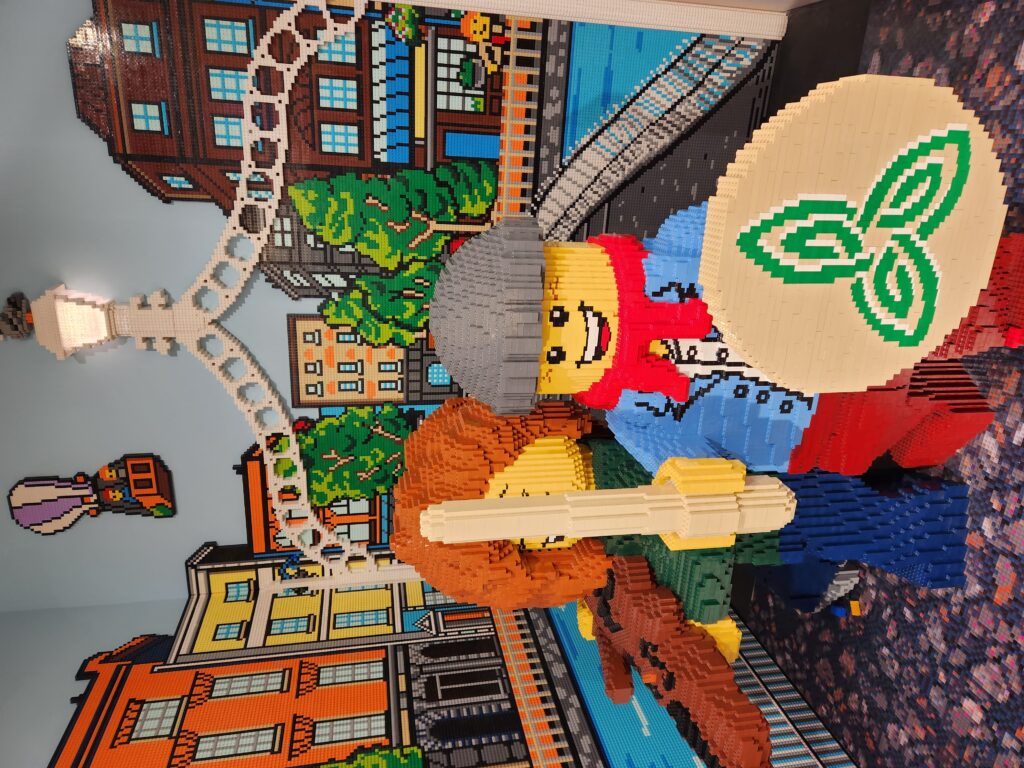
The main reason for visiting Grafton Street was just off of the main drag was a statue to Phil Lynott of Thin Lizzy, a band popular worldwide in the 70s (they did the songs “The Boys are Back in Town” and “Jailbreak”). I’ve never been a huge fan (a little too straightforward “bar rock” for me) but I have to give respect to all the bassist / singers out there!
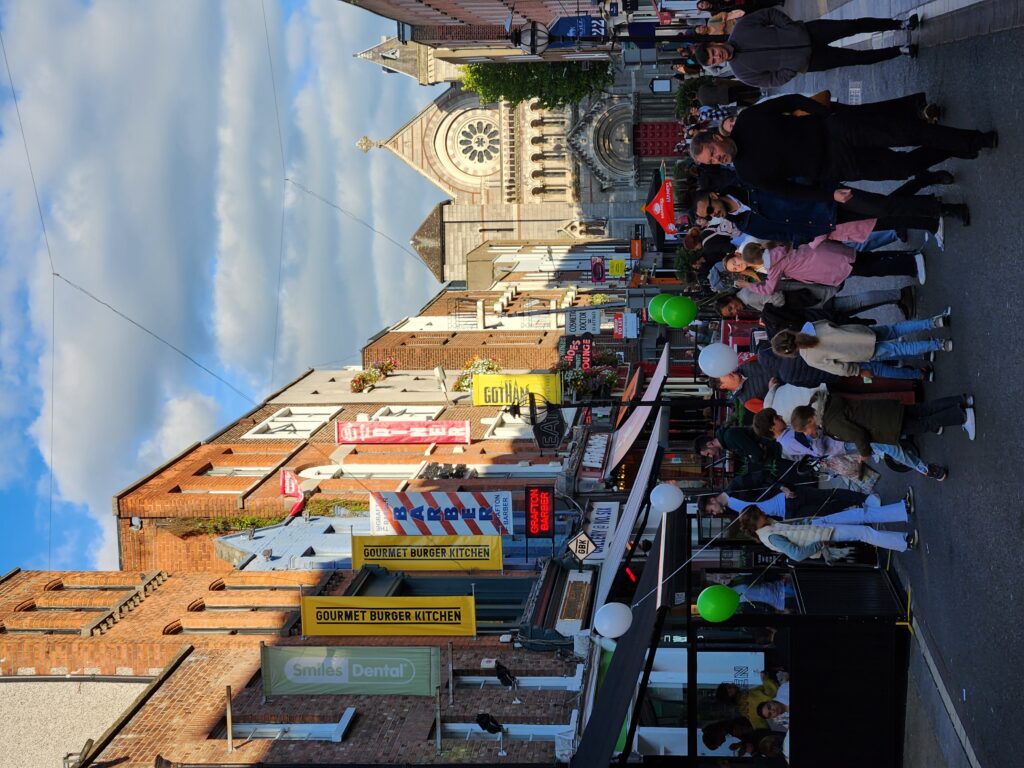
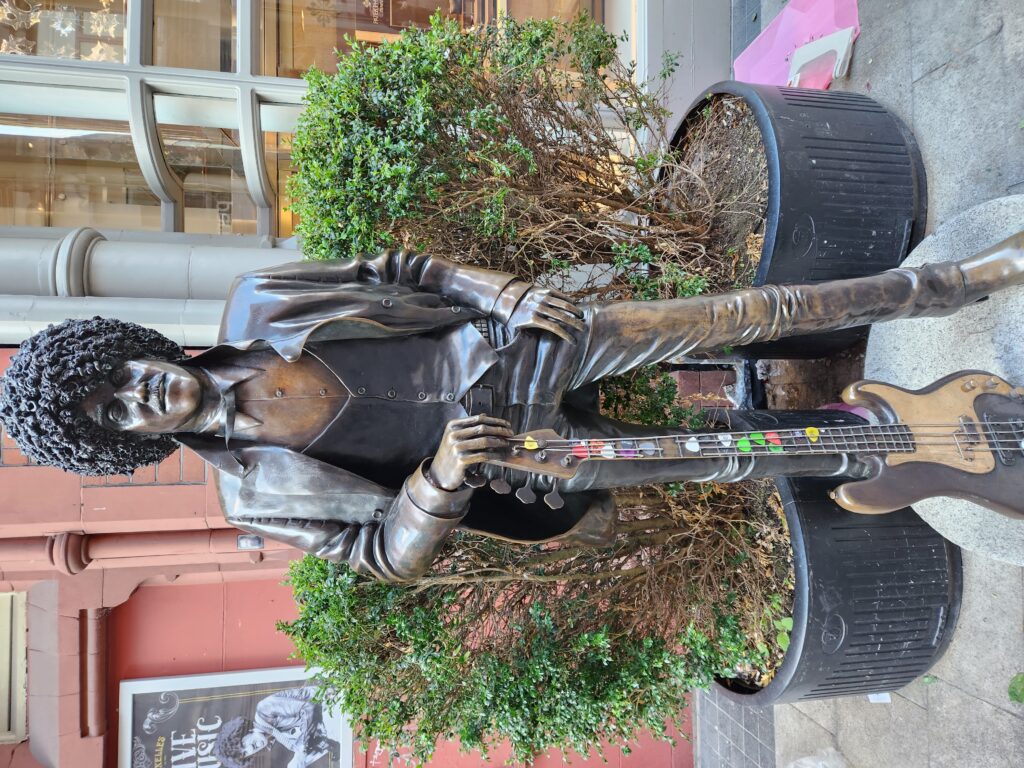
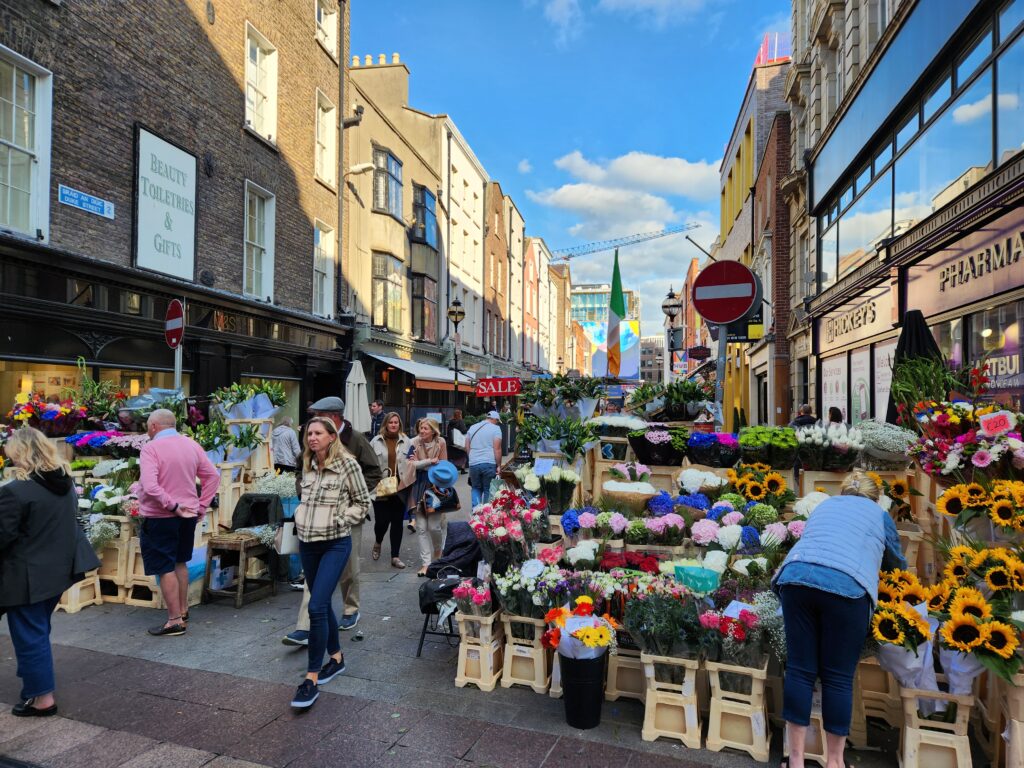
Having done with Grafton Street I turned northeast to see the Molly Malone statue. Though I wasn’t that familiar with the song (my family being more Gordon Lightfoot than traditional Irish songs) it was on the way and fairly well known so why not. All along the way I’d pop into little tourist shops hoping to find a “solar dancer”, maybe a Leprechaun or something, but nope, none to be found.
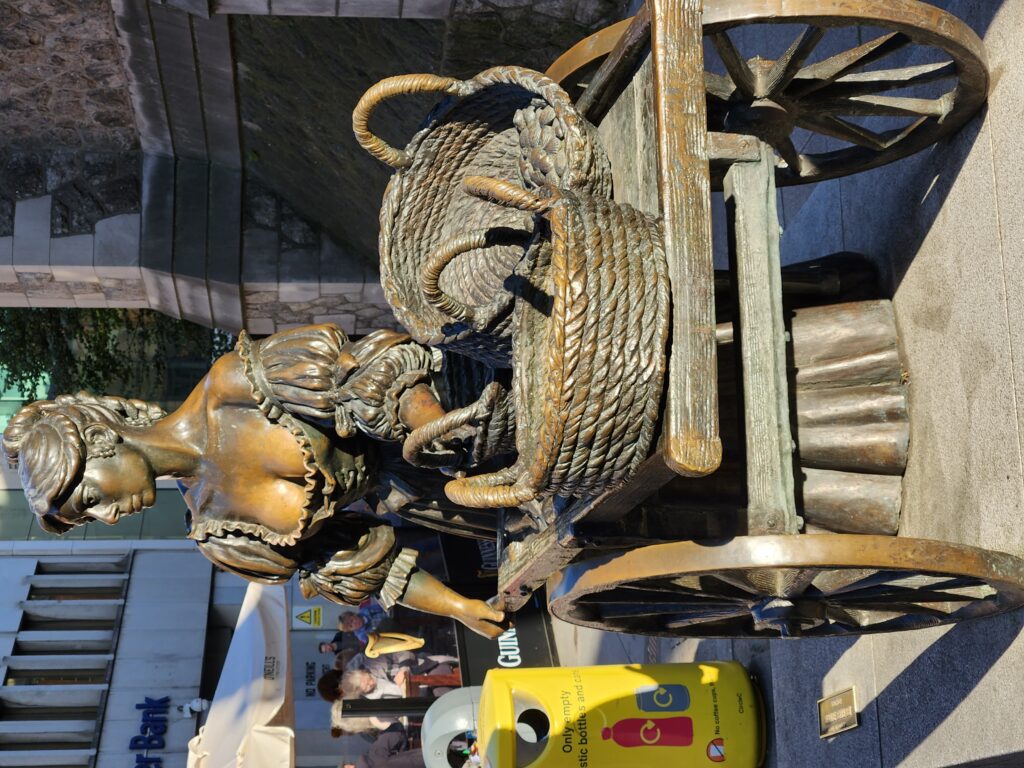
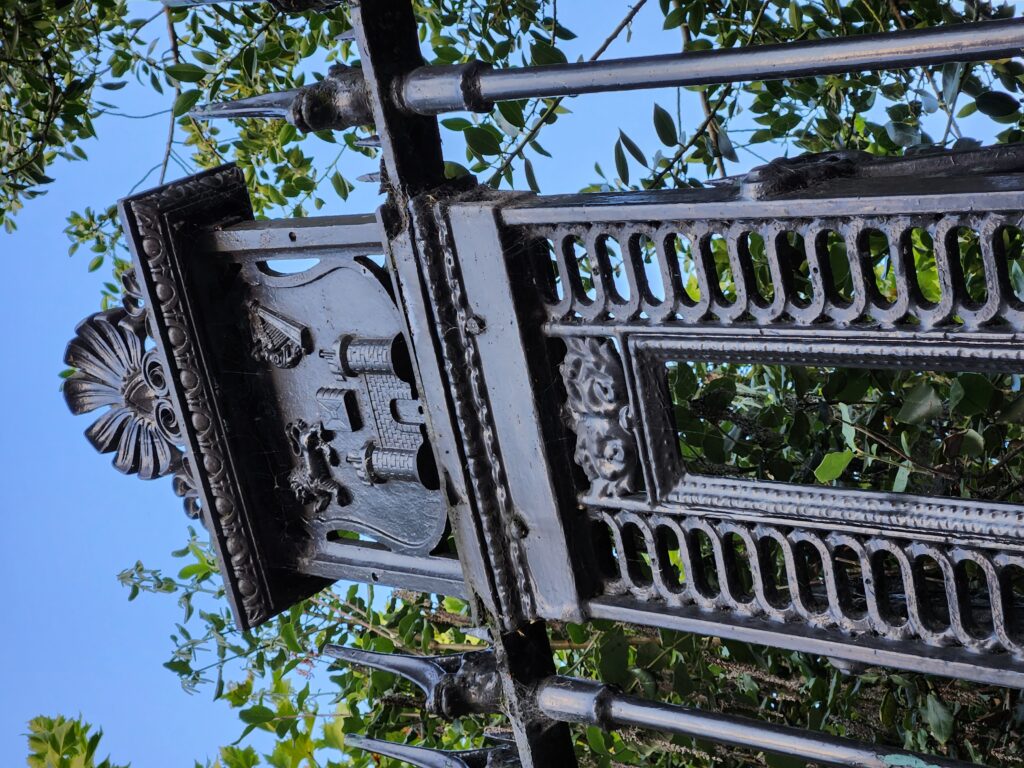
Afterwards went east along the south side of the river Liffey (and passing the beautiful Custom House — completed in 1791 — on the north bank of the river) through what looked to be more of a business district. Crossed the bridge just west of the Famine Memorial. It is impossible not to be moved by the gaunt figures cast in corroded metal — the dog with ribs jutting out, the man with his daughter slung over his back, others carrying their belongings in a small sack, etc. For someone who wouldn’t be here were it not for the famine driving my maternal ancestors to America it was particularly impactful. Over a quarter of the Irish died or moved. The famine disproportionally affected what is today the Republic of Ireland despite the blight affecting what is today Northern Ireland and Scotland. Though initially a natural disaster make no mistake it was exacerbated by humanity (or lack thereof).
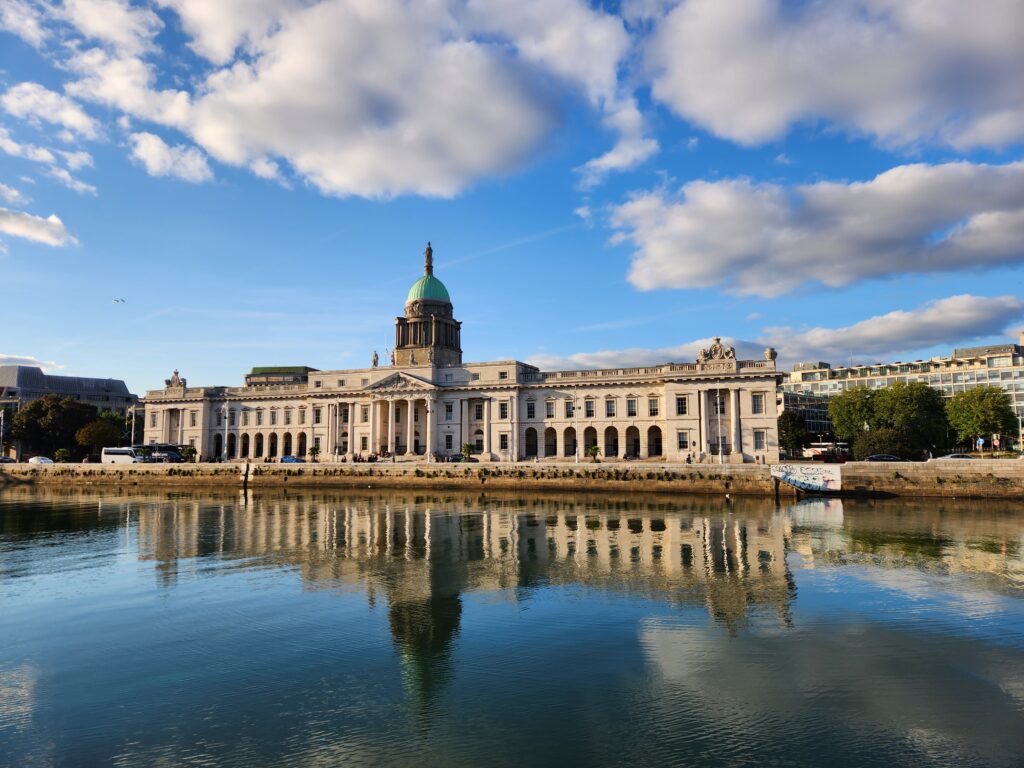
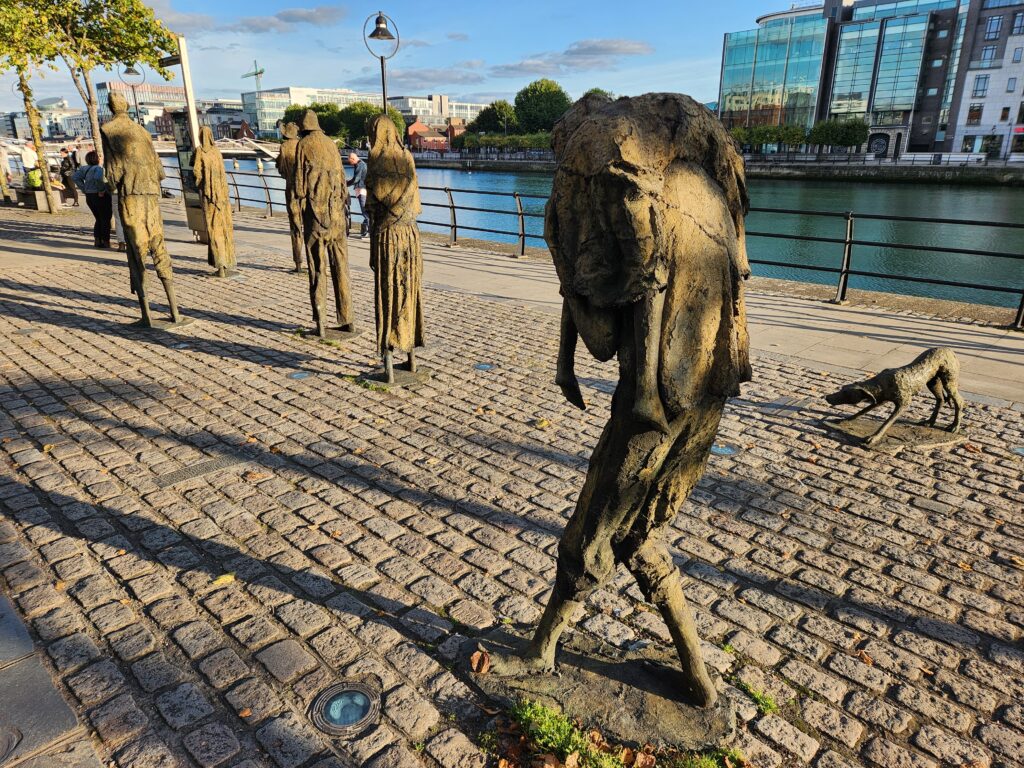
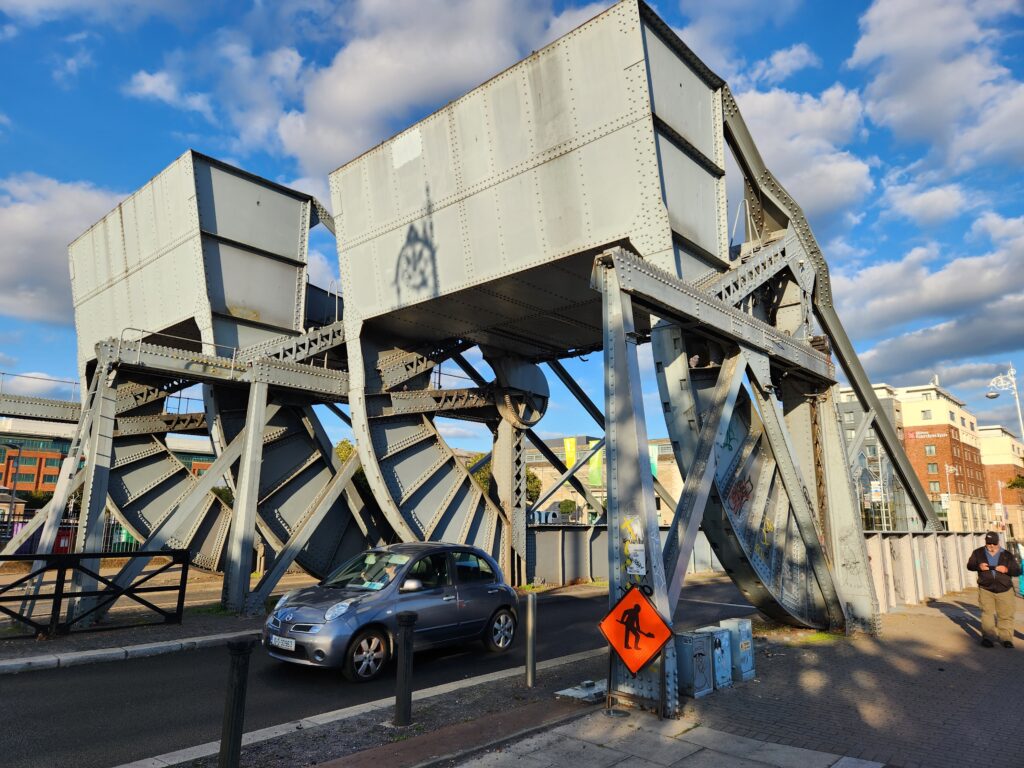
Headed a bit farther down the quay past EPIC, the museum of Irish Emigration, and, from the Sean O’Casey bridge, took photos of Jeanie Johnston, a replica of a 19th century ship that took Irish emigrants to the United States during the famine years.
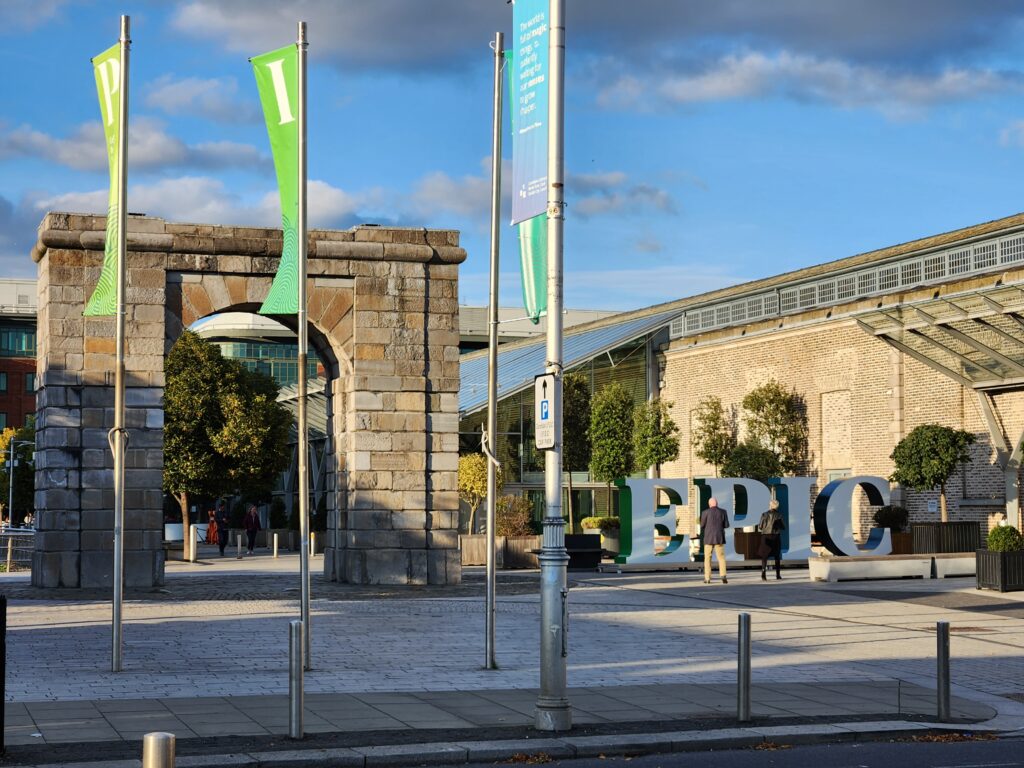
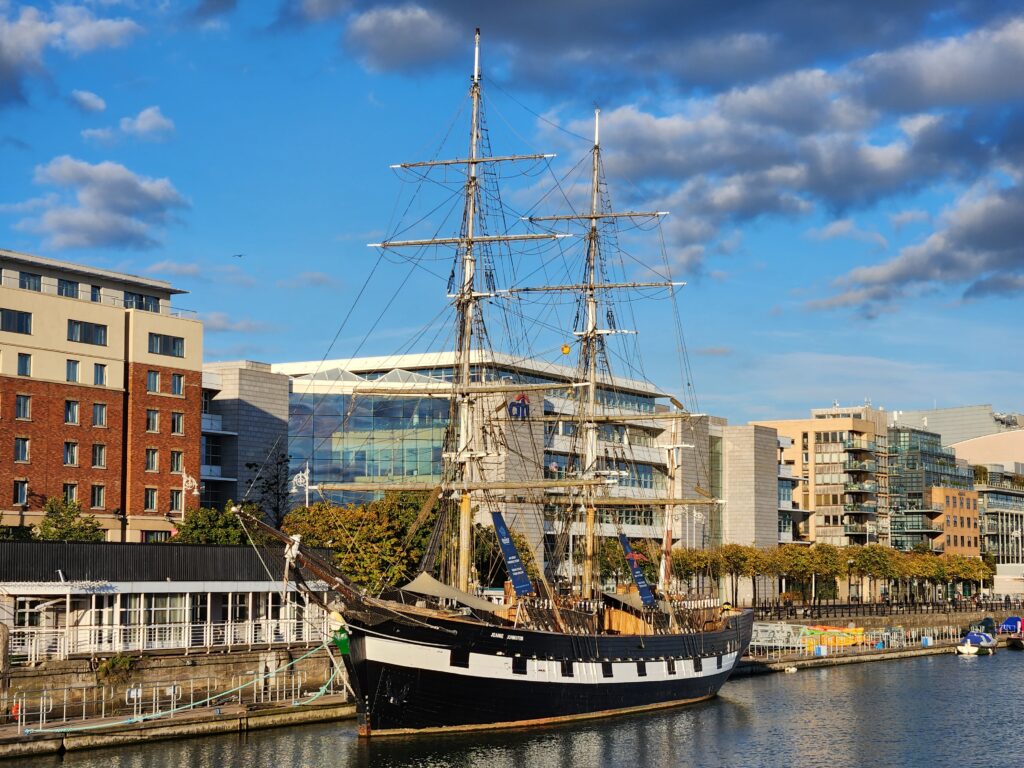
As it was getting dark I headed back to the hotel along the north bank (stopping by the Famine Memorial one more time). I stopped to take some pictures of the O’Connell Monument, built to honor a hero of Ireland on the street where some of the heaviest fighting took place during the Easter Rising in 1916. Unfortunately, The Rolling Donut was out of the Coffee Lovers — I so was going to pick one up. Arrived back at the room at around 7pm after walking about five miles. We decided rather than brave Temple Bar on a Saturday night and not really feeling like braving, well, anything, we went to the restaurant in our hotel to get a bite to eat and hopefully see some live music (to begin at 8:30pm). So, about 8pm we got our meal. Michelle started with potato soup which was excellent and we both had burgers with fries. Not bad. As it was not quite 8:30pm and neither of us drink I felt guilty lingering until the music so ordered a chocolate fudge cake with raspberry topping. It was excellent!
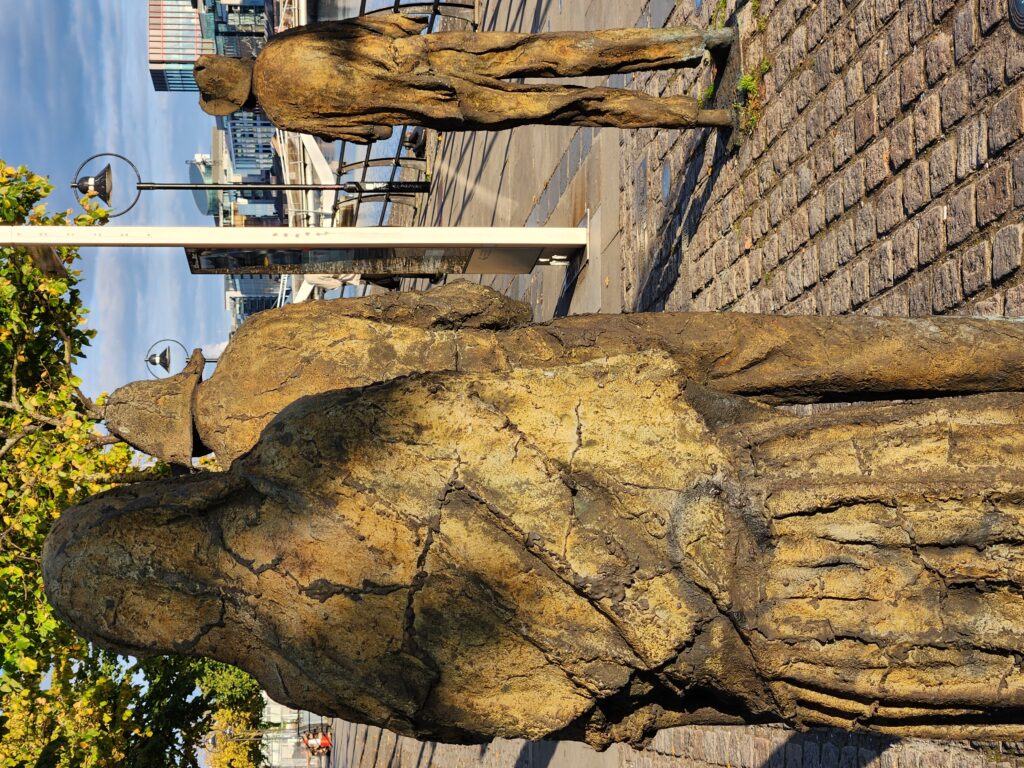
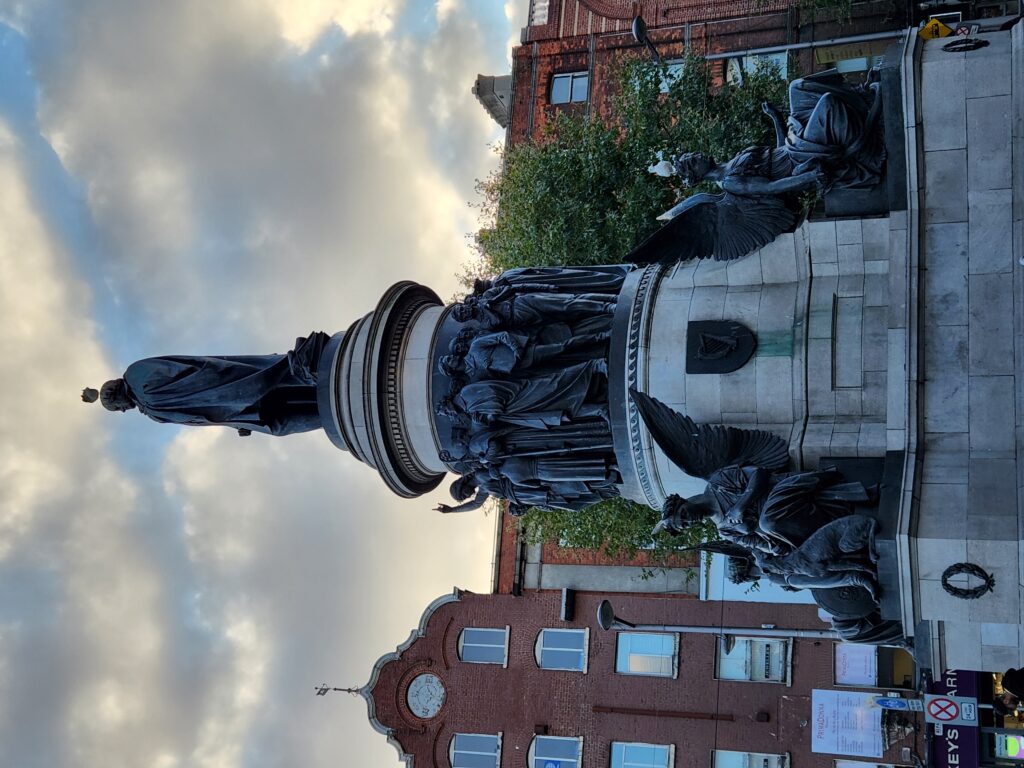
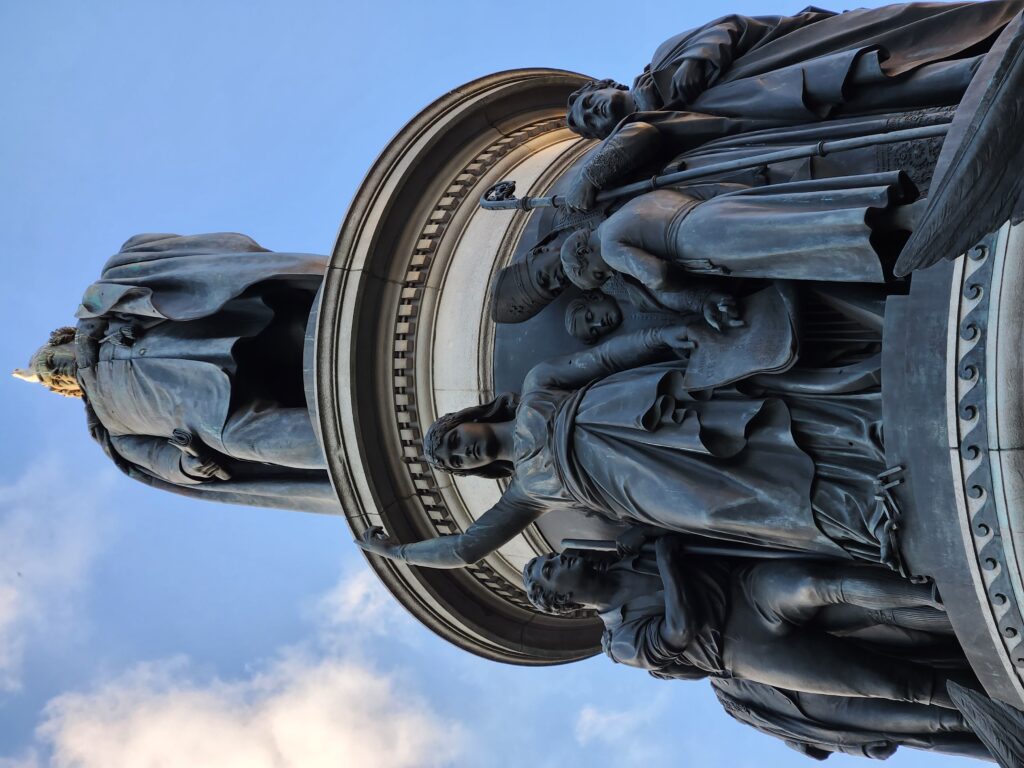
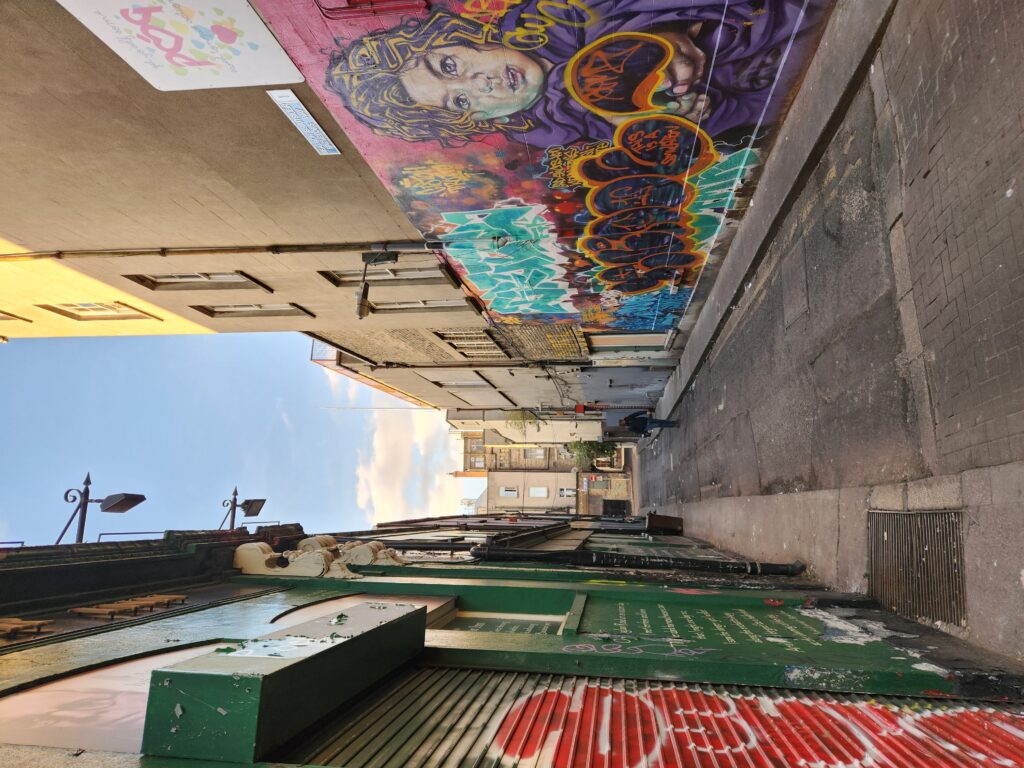
The music, however, was not… It was a guy my age (or perhaps a little younger) playing an electrified acoustic guitar. I’m sure he was skilled enough but he played just covers of American songs (and even America’s “rocks and plants and things” — laziest lyric ever). The woman at the table next to us started dancing what must have been the most awkward dance since Seinfeld’s Elaine’s dance. It was bad.
Headed back to the room and did offloading of pictures and a little blogging before heading to bed early in anticipation of an early pick up the next morning.





































